new posts in all blogs
Viewing: Blog Posts Tagged with: African-American History, Most Recent at Top [Help]
Results 1 - 25 of 42
How to use this Page
You are viewing the most recent posts tagged with the words: African-American History in the JacketFlap blog reader. What is a tag? Think of a tag as a keyword or category label. Tags can both help you find posts on JacketFlap.com as well as provide an easy way for you to "remember" and classify posts for later recall. Try adding a tag yourself by clicking "Add a tag" below a post's header. Scroll down through the list of Recent Posts in the left column and click on a post title that sounds interesting. You can view all posts from a specific blog by clicking the Blog name in the right column, or you can click a 'More Posts from this Blog' link in any individual post.

By:
Betsy Bird,
on 7/27/2016
Blog:
A Fuse #8 Production
(
Login to Add to MyJacketFlap)
JacketFlap tags:
Reviews,
nonfiction picture books,
Best Books,
picture book biographies,
Little Brown and Company,
African-American history,
Javaka Steptoe,
African-American biographies,
African-American picture book biographies,
African-American authors and illustrators,
2016 Caldecott contenders,
Best Books of 2016,
Reviews 2016,
2016 nonfiction picture books,
2016 picture book biographies,
Add a tag
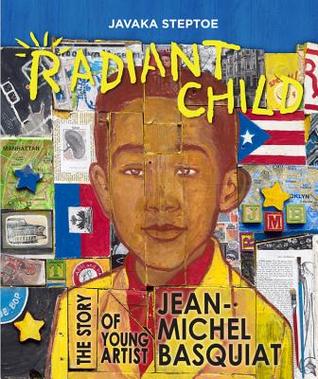 Radiant Child: The Story of Young Artist Jean-Michel Basquiat
Radiant Child: The Story of Young Artist Jean-Michel Basquiat
By Javaka Steptoe
Little, Brown & Co.
$17.99
ISBN: 978-0-316-21388-2
Ages 5 and up
On shelves October 25th
True Story: I’m working the children’s reference desk of the Children’s Room at 42nd Street of New York Public Library a couple years ago and a family walks in. They go off to read some books and eventually the younger son, I’d say around four years of age, approaches my desk. He walks right up to me, looks me dead in the eye, and says, “I want all your Javaka Steptoe books.” Essentially this child was a living embodiment of my greatest dream for mankind. I wish every single kid in America followed that little boy’s lead. Walk up to your nearest children’s librarian and insist on a full fledged heaping helping of Javaka. Why? Well aside from the fact that he’s essentially children’s book royalty (his father was the groundbreaking African-American picture book author/illustrator John Steptoe) he’s one of the most impressive / too-little-known artists working today. But that little boy knew him and if his latest picture book biography “Radiant Child: The Story of Young Artist Jean-Michel Basquiat” is even half as good as I think it is, a whole host of children will follow suit. But don’t take my word for it. Take that four-year-old boy’s. That kid knew something good when he saw it.
“Somewhere in Brooklyn, a little boy dreams of being a famous artist, not knowing that one day he will make himself a KING.” That boy is an artist already, though not famous yet. In his house he colors on anything and everything within reach. And the art he makes isn’t pretty. It’s, “sloppy, ugly, and sometimes weird, but somehow still BEAUTIFUL.” His mother encourages him, teaches him, and gives him an appreciation for all the art in the world. When he’s in a car accident, she’s the one who hands him Gray’s Anatomy to help him cope with what he doesn’t understand. Still, nothing can help him readily understand his own mother’s mental illness, particularly when she’s taken away to live where she can get help. All the same, that boy, Jean-Michel Basquiat, shows her his art, and with determination he grows up, moves to Manhattan, and starts his meteoric rise in the art scene. All this so that when, at long last, he’s at the top of his game, it’s his mother who sits on the throne at his art shows. Additional information about Basquiat appears at the back of the book alongside a key to the motifs in his work, an additional note from Steptoe himself on what Basquiat’s life and work can mean to young readers, and a Bibliography.
 Javaka Steptoe apparently doesn’t like to make things easy for himself. If he wanted to, he could illustrate all the usual African-American subjects we see in books every year. Your Martin Luther Kings and Rosa Parks and George Washington Carvers. So what projects does he choose instead? Complicated heroes who led complicated lives. Artists. Jimi Hendrix and guys like that. Because for all that kids should, no, MUST know who Basquiat was, he was an adult with problems. When Steptoe illustrated Gary Golio’s bio of Hendrix (Jimi: Sounds Like a Rainbow) critics were universal in their praise. And like that book, Steptoe ends his story at the height of Basquiat’s fame. I’ve seen some folks comment that the ending here is “abrupt” and that’s not wrong. But it’s also a natural high, and a real time in the man’s life when he was really and truly happy. When presenting a subject like Basquiat to a young audience you zero in on the good, acknowledge the bad in some way (even if it’s afterwards in an Author’s Note), and do what you can to establish precisely why this person should be mentioned alongside those Martin Luther Kings, Rosa Parks, and George Washington Carvers.
Javaka Steptoe apparently doesn’t like to make things easy for himself. If he wanted to, he could illustrate all the usual African-American subjects we see in books every year. Your Martin Luther Kings and Rosa Parks and George Washington Carvers. So what projects does he choose instead? Complicated heroes who led complicated lives. Artists. Jimi Hendrix and guys like that. Because for all that kids should, no, MUST know who Basquiat was, he was an adult with problems. When Steptoe illustrated Gary Golio’s bio of Hendrix (Jimi: Sounds Like a Rainbow) critics were universal in their praise. And like that book, Steptoe ends his story at the height of Basquiat’s fame. I’ve seen some folks comment that the ending here is “abrupt” and that’s not wrong. But it’s also a natural high, and a real time in the man’s life when he was really and truly happy. When presenting a subject like Basquiat to a young audience you zero in on the good, acknowledge the bad in some way (even if it’s afterwards in an Author’s Note), and do what you can to establish precisely why this person should be mentioned alongside those Martin Luther Kings, Rosa Parks, and George Washington Carvers.
There’s this moment in the film Basquiat when David Bowie (playing Andy Warhol) looks at some of his own art and says off-handedly, “I just don’t know what’s good anymore.” I have days, looking at the art of picture books when I feel the same way. Happily, there wasn’t a minute, not a second, when I felt that way about Radiant Child. Now I’m going to let you in on a little secret: Do you know what one of the most difficult occupations to illustrate a picture book biography about is? Artist. Because right from the start the illustrator of the book is in a pickle. Are you going to try to replicate the art of this long dead artist? Are you going to grossly insert it into your own images, even if the book isn’t mixed media to begin with? Are you going to try to illustrate the story in that artist’s style alone, relegating images of their actual art to the backmatter? Steptoe addresses all this in his Note at the back of the book. As he says, “Instead of reproducing or including copies of real Basquiat paintings in this book, I chose to create my own interpretations of certain pieces and motifs.” To do this he raided Basquiat’s old haunts around NYC for discarded pieces of wood to paint on. The last time I saw this degree of attention paid to painting on wood in a children’s book was Paul O. Zelinsky’s work on Swamp Angel. In Steptoe’s case, his illustration choice works shockingly well. Look how he manages to give the reader a sense of perspective when he presents Picasso’s “Guernica” at an angle, rather than straight on. Look how the different pieces of wood, brought together, fit, sometimes including characters on the same piece to show their closeness, and sometimes painting them on separate pieces as a family is broken apart. And the remarkable thing is that for all that it’s technically “mixed-media”, after the initial jolt of the art found on the title page (a full wordless image of Basquiat as an adult surrounded by some of his own imagery) you’re all in. You might not even notice that even the borders surrounding these pictures are found wood as well.
 The precise age when a child starts to feel that their art is “not good” anymore because it doesn’t look realistic or professional enough is relative. Generally it happens around nine or ten. A book like Radiant Child, however, is aimed at younger kids in the 6-9 year old range. This is good news. For one thing, looking at young Basquiat vs. older Basquiat, it’s possible to see how his art is both childlike and sophisticated all at once. A kid could look at what he’s doing in this book and think, “I could do that!” And in his text, Steptoe drills into the reader the fact that even a kid can be a serious artist. As he says, “In his house you can tell a serious ARTIST dwells.” No bones about it.
The precise age when a child starts to feel that their art is “not good” anymore because it doesn’t look realistic or professional enough is relative. Generally it happens around nine or ten. A book like Radiant Child, however, is aimed at younger kids in the 6-9 year old range. This is good news. For one thing, looking at young Basquiat vs. older Basquiat, it’s possible to see how his art is both childlike and sophisticated all at once. A kid could look at what he’s doing in this book and think, “I could do that!” And in his text, Steptoe drills into the reader the fact that even a kid can be a serious artist. As he says, “In his house you can tell a serious ARTIST dwells.” No bones about it.
How much can a single picture book bio do? Pick a good one apart and you’ll see all the different levels at work. Steptoe isn’t just interested in celebrating Basquiat the artist or encouraging kids to keep working on their art. He also notes at the back of the book that the story of Basquiat’s relationship with his mother, who suffered from mental illness, was very personal to him. And so, Basquiat’s mother remains an influence and an important part of his life throughout the text. You might worry, and with good reason, that the topic of mental illness is too large for a biography about someone else, particularly when that problem is not the focus of the book. How do you properly address such an adult problem (one that kids everywhere have to deal with all the time) while taking care to not draw too much attention away from the book’s real subject? Can that even be done? Sacrifices, one way or another, have to be made. In Radiant Child Steptoe’s solution is to show Jean-Michel within the lens of his art’s relationship to his mother. She talks to him about art, takes him to museums, and encourages him to keep creating. When he sees “Guernica”, it’s while he’s holding her hand. And because Steptoe has taken care to link art + mom, her absence is keenly felt when she’s gone. The book’s borders go a dull brown. Just that single line “His mother’s mind is not well” says it succinctly. Jean-Michel is confused. The kids reading the book might be confused. But the feeling of having a parent you are close to leave you . . . we can all relate to that, regardless of the reason. It’s just going to have a little more poignancy for those kids that have a familiarity with family members that suffer mental illnesses. Says Steptoe, maybe with this book those kids can, “use Basquiat’s story as a catalyst for conversation and healing.”
That’s a lot for a single picture book biography to take on. Yet I truly believe that Radiant Child is up to the task. It’s telling that in the years since I became a children’s librarian I’ve seen a number of Andy Warhol biographies and picture books for kids but the closest thing I ever saw to a Basquiat bio for children was Life Doesn’t Frighten Me as penned by Maya Angelou, illustrated by Jean-Michel. And that wasn’t even really a biography! For a household name, that’s a pretty shabby showing. But maybe it makes sense that only Steptoe could have brought him to proper life and to the attention of a young readership. In such a case as this, it takes an artist to display another artist. Had Basquiat chosen to create his own picture book autobiography, I don’t think he could have done a better job that what Radiant Child has accomplished here. Timely. Telling. Overdue.
On shelves October 25th.
Source: F&G sent from publisher for review.
Professional Reviews: A star from Kirkus


By:
Betsy Bird,
on 6/29/2016
Blog:
A Fuse #8 Production
(
Login to Add to MyJacketFlap)
JacketFlap tags:
picture book poetry,
African-American authors and illustrators,
Best Books of 2016,
2016 reviews,
Reviews 2016,
2016 poetry,
Reviews,
history,
poetry,
Simon and Schuster,
Atheneum,
Best Books,
Ashley Bryan,
multicultural children's literature,
African-American history,
Add a tag
 Freedom Over Me: Eleven slaves, their lives and dreams brought to life
Freedom Over Me: Eleven slaves, their lives and dreams brought to life
By Ashley Bryan
Atheneum (an imprint of Simon & Schuster)
$17.99
ISBN: 978-1481456906
Ages 9 and up
On shelves September 13th
Who gives voice to the voiceless? What are your credentials when you do so? When I was a teen I used to go into antique stores and buy old family photographs from the turn of the century. It still seems odd to me that this is allowed. I’d find the people who looked the most interesting, like they had a story to tell, and I’d take them home with me. Then I’d write something about their story, though mostly I just liked to look at them. There is a strange comfort in looking at the faces of the fashionable dead. A little twinge of momento mori mixed with the knowledge that you yourself are young (possibly) and alive (probably). It’s easy to hypothesize about a life when you can see that person’s face and watch them in their middle class Sunday best. It is far more difficult when you have no face, a hint of a name, and/or maybe just an age. Add to this the idea that the people in question lived through a man made hell-on-earth. When author/illustrator/artist Ashley Bryan acquired a collection of slave-related documents from the 1820s to the 1860s he had in his hands a wealth of untold stories. And when he chose to give these people, swallowed by history, lives and dignity and peace, he did so as only he could. With the light and laughter and beauty that only he could find in the depths of uncommon pain. Freedom Over Me is a work of bravery and sense. A way of dealing with the unimaginable, allowing kids an understanding that there is a brain, heart, and soul behind every body, alive or dead, in human history.
The date on the Fairchilds Appraisement is July 5, 1828. On it you will find a list of goods to be sold. Cows, hogs, cotton . . . and people. Eleven people, if we’re going to be precise (and we are). Most have names. One does not. Just names on a piece of paper almost 200-years-old. So Ashley Bryan, he takes those names and those people, and for the first time in centuries we get to meet them. Here is Athelia, a laundress who once carried the name Adero. On one page we hear about her life. On the next, her dreams. She remembers the village she grew up in, the stories, and the songs. And she is not alone in this. As we meet each person and learn what they do, we get a glimpse into their dreams. We hear their hopes. We wonder about their lives. We see them draw strength from one another. And in the end? The sale page sits there. The final words: “Administered to the best of our Judgment.”
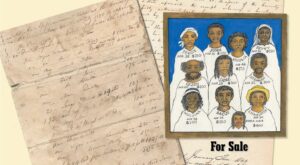 I have often said, and I say it to this day, that if there were ever a Church of Ashley Bryan, every last person who has ever met him or heard him speak would be a member. There are only a few people on this great green Earth that radiant actual uncut goodness right through their very pores. Mr. Bryan is one of those few, so when I asked at the beginning of this review what the credentials are for giving voice to the voiceless, check off that box. There are other reasons to trust him, though. A project of this sort requires a certain level of respect for the deceased. To attain that, and this may seem obvious, the author has to care. Read enough books written for kids and you get a very clear sense of those books written by folks who do not care vs. folks that do. Even then, caring’s not really enough. The writing needs to be up to speed and the art needs to be on board. And for this particular project, Ashley Bryan had a stiffer task at hand. Okay. You’ve given them full names and backgrounds and histories. What else do they need? Bryan gives these people something intangible. He gives them dreams. It’s right there in the subtitle, actually: “Eleven slaves, their lives and dreams brought to life.”
I have often said, and I say it to this day, that if there were ever a Church of Ashley Bryan, every last person who has ever met him or heard him speak would be a member. There are only a few people on this great green Earth that radiant actual uncut goodness right through their very pores. Mr. Bryan is one of those few, so when I asked at the beginning of this review what the credentials are for giving voice to the voiceless, check off that box. There are other reasons to trust him, though. A project of this sort requires a certain level of respect for the deceased. To attain that, and this may seem obvious, the author has to care. Read enough books written for kids and you get a very clear sense of those books written by folks who do not care vs. folks that do. Even then, caring’s not really enough. The writing needs to be up to speed and the art needs to be on board. And for this particular project, Ashley Bryan had a stiffer task at hand. Okay. You’ve given them full names and backgrounds and histories. What else do they need? Bryan gives these people something intangible. He gives them dreams. It’s right there in the subtitle, actually: “Eleven slaves, their lives and dreams brought to life.”
And so the book is a work of fiction. There is no amount of research that could discover Bacus or Peggy or Dora’s true tales. So when we say that Bryan is giving these people their lives back, we acknowledge that the lives he’s giving them aren’t the exact lives they led. And so we know that each person is a representative above and beyond the names on that page. Hence the occupations. Betty is every gardener. Stephen every architect. Dora every child that was born to a state of slavery and labored under it, perhaps their whole lives. And there is very little backmatter included in this book. Bryan shows the primary documents alongside a transcription of the sales. There is also an Author’s Note. Beyond that, you bring to the book what you already know about slavery, making this a title for a slightly older child readership. Bryan isn’t going to spend these pages telling you every daily injustice of slavery. Kids walk in with that knowledge already in place. What they need now is some humanity.
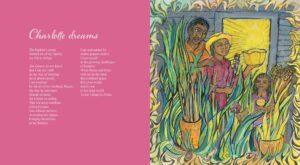 Has Mr. Bryan ever done anything with slavery before? I was curious. I’ve watched Mr. Bryan’s books over the years and they are always interesting. He’s done spirituals as cut paper masterpieces. He’s originated folktales as lively and quick as their inspirational forbears. He makes puppets out of found objects that carry with them a feeling not just of dignity, but pride. But has he ever directly done a book that references slavery? So I examined his entire repertoire, from the moment he illustrated Black Boy by Richard Wright to Susan Cooper’s Jethro and the Jumbie to Ashley Bryan’s African Folktales, Uh-Huh and beyond. His interest in Africa and song and poetry knows no bounds, but never has he engaged so directly with slavery itself.
Has Mr. Bryan ever done anything with slavery before? I was curious. I’ve watched Mr. Bryan’s books over the years and they are always interesting. He’s done spirituals as cut paper masterpieces. He’s originated folktales as lively and quick as their inspirational forbears. He makes puppets out of found objects that carry with them a feeling not just of dignity, but pride. But has he ever directly done a book that references slavery? So I examined his entire repertoire, from the moment he illustrated Black Boy by Richard Wright to Susan Cooper’s Jethro and the Jumbie to Ashley Bryan’s African Folktales, Uh-Huh and beyond. His interest in Africa and song and poetry knows no bounds, but never has he engaged so directly with slavery itself.
Could this have been done as anything but poetry? Or would you even call each written section poetry? I would, but I’ll be interested to see where libraries decide to shelve the book. Do you classify it as poetry or in the history section under slavery? Maybe, for all that it seems to be the size and shape of a picture book, you’d put it in your fiction collection. Wherever you put it, I am reminded, as I read this book, of Good Masters! Sweet Ladies! where every lord and peasant gets a monologue from their point of view. Freedom Over Me bears more than a passing similarity to Good Masters. In both cases we have short monologues any kid could read aloud in class or on their own. They are informed by research, and their scant number of words speak to a time we’ll never really know or understand fully. And how easy it would be to turn this book into a stage play. I can see it so easily. Imagine if you turned the Author’s Note into the first monologue and Ashley Bryan his own character (behold the 10-year-old dressed up as him, mustache and all). Since the title of the book comes from the spiritual “Oh, Freedom!” you could either have the kids sing it or play it in the background. And for the ending? A kid playing the lawyer or possibly Mrs. Fairchilds or even Ashley comes out and reads the statement at the end with each person and their price and the kids step forward holding some object that defines them (clothing sewn, books read, paintings, etc.). It’s almost too easy.
 The style of the art was also interesting to me. Pen, ink, and watercolors are all Mr. Bryan (who is ninety-two years of age, as of this review) needs to render his people alive. I’ve see him indulge in a range of artistic mediums over the years. In this book, he begins with an image of the estate, an image of the slaves on that estate, and then portraits and renderings of each person, at rest or active in some way. “Peggy” is one of the first women featured, and for her portrait Ashley gives her face whorls and lines, not dissimilar to those you’d find in wood. This technique is repeated, to varying degrees, with the rest of the people in the book. First the portrait. Then an image of what they do in their daily lives or dreams. The degree of detail in each of these portraits changes a bit. Peggy, for example, is one of the most striking. The colors of her skin, and the care and attention with which each line in her face is painted, make it clear why she was selected to be first. I would have loved the other portraits to contain this level of detail, but the artist is not as consistent in this regard. Charlotte and Dora, for example, are practically line-less, a conscious choice, but a kind of pity since Peggy’s portrait sets you up to think that they’ll all look as richly detailed and textured as she.
The style of the art was also interesting to me. Pen, ink, and watercolors are all Mr. Bryan (who is ninety-two years of age, as of this review) needs to render his people alive. I’ve see him indulge in a range of artistic mediums over the years. In this book, he begins with an image of the estate, an image of the slaves on that estate, and then portraits and renderings of each person, at rest or active in some way. “Peggy” is one of the first women featured, and for her portrait Ashley gives her face whorls and lines, not dissimilar to those you’d find in wood. This technique is repeated, to varying degrees, with the rest of the people in the book. First the portrait. Then an image of what they do in their daily lives or dreams. The degree of detail in each of these portraits changes a bit. Peggy, for example, is one of the most striking. The colors of her skin, and the care and attention with which each line in her face is painted, make it clear why she was selected to be first. I would have loved the other portraits to contain this level of detail, but the artist is not as consistent in this regard. Charlotte and Dora, for example, are practically line-less, a conscious choice, but a kind of pity since Peggy’s portrait sets you up to think that they’ll all look as richly detailed and textured as she.
Those old photographs I once collected may well be the only record those people left of themselves on this earth, aside from a name in a family tree and perhaps on a headstone somewhere. So much time has passed since July 5, 1828 that it is impossible to say whether or not the names on Ashley’s acquired Appraisement are remembered by their descendants. Do families still talk about Jane or Qush? Is this piece of paper the only part of them that remains in the world? It may not have been the lives they led, but Ashley Bryan does everything within his own personal capacity to keep these names and these people alive, if just for a little longer. Along the way he makes it clear to kids that slaves weren’t simply an unfortunate mass of bodies. They were architects and artists and musicians. They were good and bad and human just like the rest of us. Terry Pratchett once wrote that sin is when people treat other people as objects. Ashley treats people as people. And times being what they are, here in the 21st century I’d say that’s a pretty valuable lesson to be teaching our kids today.
On shelves September 13th.
Source: Galley sent from publisher for review.
Like This? Then Try:
Professional Reviews: A star from Kirkus
Misc: Interested in the other books Mr. Bryan has written or illustrated over the course of his illustrious career? See the full list on his website here.

On January 19th, Claire Fallon, a Books and Culture Writer at The Huffington Post, wrote an article called 13 Honest Books About Slavery Young People Should Actually Read. The piece was a response to the news about Scholastic pulling the publication of A Birthday Cake for George Washington and got shared hither and thither and yon (mostly yon). It’s not a bad list by any means, but looking at it I was struck by how old the titles were. Nightjohn is from 1993. The Glory Field from 1994. Even the most recent title on the list, Never Forgotten by Patricia McKissack, originally dates to 2011.
I love older books, but there’s nothing wrong with including recent titles as well. With that in mind, here is a companion list of thirteen books about slavery for young people published in the last five years.
The Amazing Age of John Roy Lynch By Chris Barton, illustrated by Don Tate
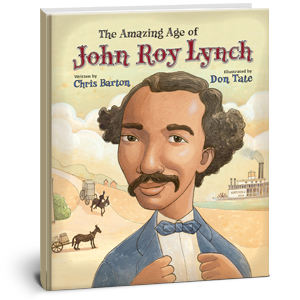 Best dang book about Reconstruction you’ll ever read to a kid. I find that when I try to sell this book to adults their eyes glaze over at the word “Reconstruction”. Kids don’t know anything about it so they’re a bit less prejudiced in that respect. A great story about a great man. As Barton puts it, “It’s the story of a guy who in ten years went from teenage field slave to U.S. Congressman.”
Best dang book about Reconstruction you’ll ever read to a kid. I find that when I try to sell this book to adults their eyes glaze over at the word “Reconstruction”. Kids don’t know anything about it so they’re a bit less prejudiced in that respect. A great story about a great man. As Barton puts it, “It’s the story of a guy who in ten years went from teenage field slave to U.S. Congressman.”
Jefferson’s Sons by Kimberly Brubaker Bradley

Long before she’d win a Newbery Honor for The War That Saved My Life, Ms. Bradley was earning my respect with a book that dared to delve into the lives of Thomas Jefferson’s enslaved children. It’s an issue complicated enough for adult readers, but Baker managed to make it understandable to a middle grade audience. I thought she’d get some award recognition for her efforts. Not that time around, but the awards would certainly get her in the end.
Words Set Me Free: The Story of Young Frederick Douglass by Lesa Cline-Ransome, illustrated by James E. Ransome
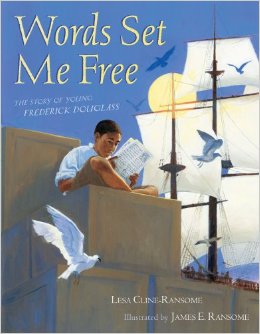
Lesa and James are a husband and wife team that just keep on producing great book after great book to too little fanfare. Their take on Douglass’s life comes after James did meticulous historical research to get the clothing and dress of the time period exactly right. A very well done bio of a famous figure in his youth.
Africa Is My Home: A Child of the Amistad by Monica Edinger, illustrated by Robert Byrd

One of those books that should really be better known. You may think you know the story of The Amistad but boy howdy you’d be wrong. Monica’s book follows the true story of Magulu, one of the children taken on the boat, and it is just one of the best pieces of writing and research on the topic you will find. Plus the story is engrossing. That doesn’t hurt.
Underground: Finding the Light to Freedom by Shane W. Evans

As you read the story, pay close attention to what’s going on in the art. Though it’s not obvious, there’s a subplot about one of the pregnant slaves running away and the baby she gives birth to in the middle of her escape.
I Lay My Stitches Down: Poems of American Slavery by Cynthia Grady, illustrated by Michele Wood

Not many books of poetry out there about slavery these days. Make sure you pull out this book not just for Black History Month but in April for Poetry Month as well.
The Underground Abductor by Nathan Hale

If you haven’t read this by now then you are seriously missing out. Absolutely, without a doubt, a nail-biting tale and all true true true. Again, I thought I knew Harriet Tubman’s life. I could not have been more wrong. If you read no other book on this list, read this one.
All Different Now: Juneteenth, the First Day of Freedom by Angela Johnson, illustrated by E.B. Lewis
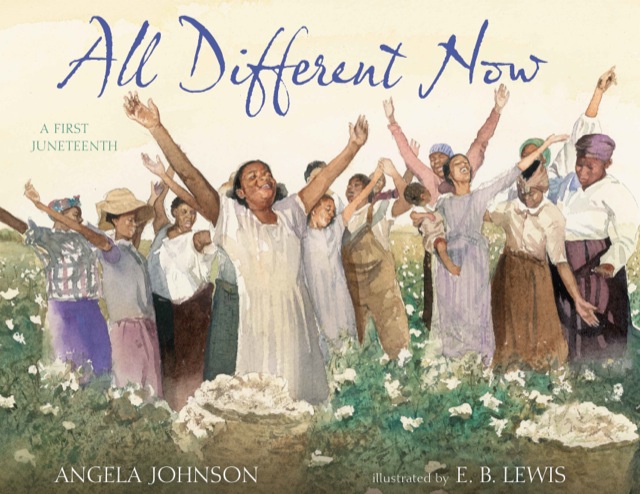
When I lived in New York I lived in Harlem. Each and every year on Juneteenth there would be a great big street fair in celebration going down 116th Street. A friend of mine visited one Juneteenth and had never heard of the celebration before. Can you think of a better reason for Johnson and Lewis’s book to gain a little more attention?
Heart and Soul: The Story of America and African Americans
by Kadir Nelson
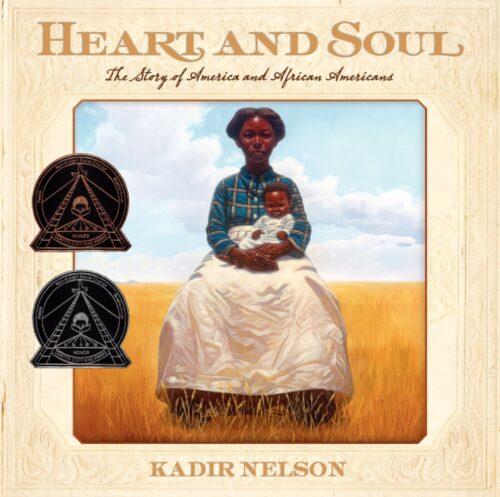
Since this book encompasses a great deal of African-American history, not just slavery, I wondered if I should include it here. But then looking back at it and remembering how well Nelson encapsulates everything from the tale of one of George Washington’s slaves to the free men who fought for the Union side during the Civil War . . . well, it would be ridiculous not to include it.
Hand in Hand: Ten Black Men Who Changed America by Andrea Davis Pinkney, illustrated by J. Brian Pinkney
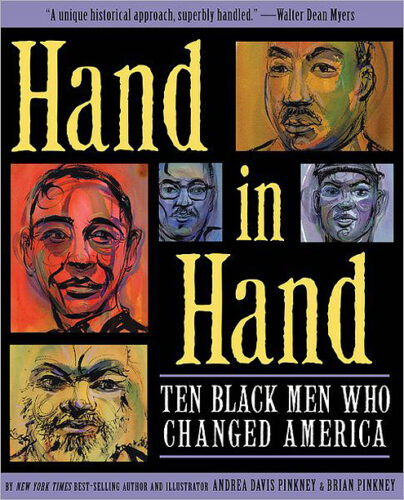
Again, not including this book on this list would leave a gap a mile wide. Andrea Davis Pinkey, let us remember, is a killer writer. This book was released in a rather silent, sly way. A lot of year end Best Of lists missed it. Make sure you don’t miss it yourself. Some of the biographies here are the best you’ll ever find for a young audience.
The Other Side of Free by Krista Russell

Remember, you must never ever judge a book by its cover? It applies here. I described the book in my review this way: “We’ve all heard of how slaves would escape to the North when they wished to escape for good. But travel a bit farther back in time to the early 18th century and the tale is a little different. At that point in history slaves didn’t flee north but south to Spain’s territories. There, the Spanish king promised freedom for those slaves that swore fidelity to the Spanish crown and fought on his behalf against the English. 13-year-old Jem is one of those escaped slaves, but his life at Fort Mose is hardly stimulating. Kept under the yoke of a hard woman named Phaedra, Jem longs to fight for the king and to join in the battles. But when at last the fighting comes to him, it isn’t at all what he thought it would be.”
Brick by Brick by Charles R. Smith Jr., illustrated by Floyd Cooper
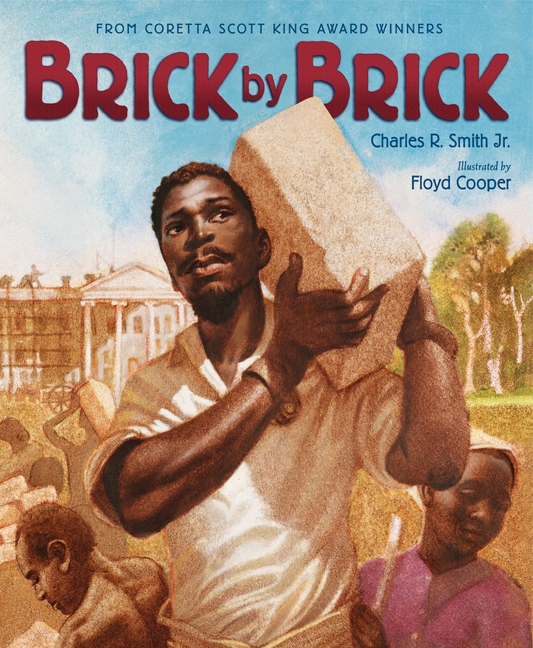
The first book I read for kids that really delved deeply into the fact that the White House was built on the backs of slaves. Smith and Cooper make for a winning team.
Freedom in Congo Square by Carole Boston Weatherford, illustrated by R. Gregory Christie
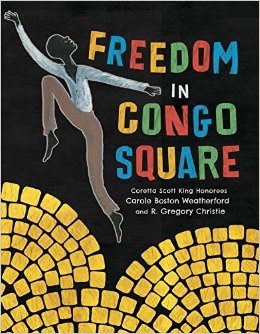
Take a good long look at this 2016 release. You’re going to be hearing a lot more about it in the months to come.
Seeking out some recent titles about African-Americans, not just slaves, in children’s literature? Check out last year’s African-American Experience Children’s Literary Reference Guide (2010-2015). I’ll be updating it to be 2011-2016 in February.
And finally, in related news, the Delaware House recently passed an official apology for slavery. Thanks to @debraj112 for the alert.


By:
Betsy Bird,
on 1/18/2016
Blog:
A Fuse #8 Production
(
Login to Add to MyJacketFlap)
JacketFlap tags:
Reviews,
Best Books,
Candlewick,
African-American history,
picture book poetry,
Roxane Orgill,
2012 Caldecott contender,
African-American authors and illustrators,
African-American books,
Best Books of 2016,
Reviews 2016,
2016 poetry,
Francis Vallejo,
Add a tag
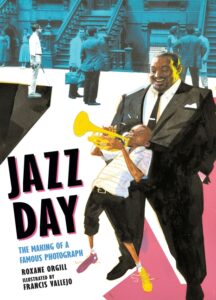 Jazz Day: The Making of a Famous Photograph
Jazz Day: The Making of a Famous Photograph
By Roxane Orgill
Illustrated by Francis Vallejo
Candlewick Press
$18.99
ISBN: 9780763669546
Ages 9-12
On shelves March 8th
Some books for kids have a hard road ahead of them. Here’s a secret. If you want a book to sell just oodles and oodles of copies to the general public, all you have to do is avoid writing in one of two specific genres: poetry and nonfiction. Even the best and brightest nonfiction books have a nasty tendency to fade from public memory too soon, and poetry only ever gets any notice during April a.k.a National Poetry Month. I say that, and yet there are some brave souls out there who will sometimes not just write poetry. Not just write nonfiction. They’ll write nonfiction-inspired poetry. It’s crazy! It’s like they care about the quality of the content more than make a bazillion dollars or something. The latest book to fall into this category is Jazz Day: The Making of a Famous Photograph by Roxane Orgill. Melding topics like jazz musicians and photography with history, poetry, and some truly keen art, this isn’t really like any other book on your shelves. I’m betting that that’s a good thing too.
It was sort of a crazy idea for a graphic designer / jazz buff to come up with. By 1958 jazz was a well-established, deeply American, musical genre. So why not try to get all the jazz greats, and maybe some up-and-comers, into a single photograph all together? The call went out but Art Kane (who really wasn’t a photographer himself) had no idea who would turn up. After all, they were going to take the picture at ten in the morning. That’s a time most jazz performers are fast asleep. Yet almost miraculously they came. Count Basie and Thelonious Monk. Maxine Sullivan and Dizzy Gillespie. Some of them were tired. Some were having a great time catching up with old friends. And after much cajoling on Kane’s part a photo was made. Fifty-seven musicians (fifty-eight if you count Willie “Lion” Smith just out of frame). Orgill tells the tale in poetry, with artist Francis Vallejo providing the art and life. Extensive backmatter consists of an Author’s Note, Biographies, a page on the photo and homages to it, Source Notes, and a Bibliography that includes Books, Articles, Audiovisual Material, and Websites.
Jazz is often compared to poetry. So giving this book too rigid a structure wouldn’t offer the right feel at all. I’m no poet. I wish I had a better appreciation for the art than I do. Yet even with my limited understanding of the style I found myself stopping when I read the poem “This Moment” written from the point of view of Eddie Locke, a drummer. It’s the kind of poem where it’s composed as a series of quatrains. The second and fourth lines of each stanza are repeated as the first and third lines of the next. It was fortunate for me that Orgill mentions in the back of the book that the poem is a pantoum. I’d never have come up with that term myself (I thought it was a sestina). Most of the poetry in the book isn’t really that formal. In fact, Orgill confesses that, “I write prose, not poetry. But this story demanded a sense of freedom, an intensity, and a conciseness that prose could not provide.” The result is that most of the poems are free verse, which I much preferred.
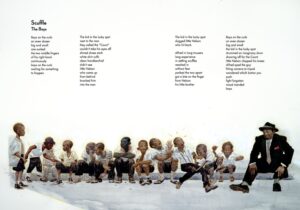 Did you know that when publishing a book for kids you’re not supposed to turn in your manuscript with an illustrator already attached? True fact. Editors like having the power to pair authors and artists together. To be honest, they have experience in this area and sometimes their intervention is sublime (sometimes it fails miserably too, but that’s a tale for another day). I’m afraid I don’t know what Candlewick editor saw Orgill’s manuscript and thought of Francis Vallejo as a potential illustrator. If I knew I’d kiss them. Detroit born Vallejo is making his debut with this book and you’d never know in a million years that he wasn’t a born and bred Harlemite. His style is perfect for this tale. As adept at comic style panels as he is acrylic and pastel jazz scenes, there’s life in this man’s art. It was born to accompany jazz. It’s also particularly interesting watching what he does with light. The very beginning of the book shows a sunrise coming up on a hot August day. As it rises, shadows make way. This play between light and shadow, between the heat of the photo shoot and the cool jazz clubs that occasionally make an appearance in the text, gives the book its heart. It’s playful and serious all at once so that when you lift the page that reveals the real photograph, that action produces a very real moment of awe.
Did you know that when publishing a book for kids you’re not supposed to turn in your manuscript with an illustrator already attached? True fact. Editors like having the power to pair authors and artists together. To be honest, they have experience in this area and sometimes their intervention is sublime (sometimes it fails miserably too, but that’s a tale for another day). I’m afraid I don’t know what Candlewick editor saw Orgill’s manuscript and thought of Francis Vallejo as a potential illustrator. If I knew I’d kiss them. Detroit born Vallejo is making his debut with this book and you’d never know in a million years that he wasn’t a born and bred Harlemite. His style is perfect for this tale. As adept at comic style panels as he is acrylic and pastel jazz scenes, there’s life in this man’s art. It was born to accompany jazz. It’s also particularly interesting watching what he does with light. The very beginning of the book shows a sunrise coming up on a hot August day. As it rises, shadows make way. This play between light and shadow, between the heat of the photo shoot and the cool jazz clubs that occasionally make an appearance in the text, gives the book its heart. It’s playful and serious all at once so that when you lift the page that reveals the real photograph, that action produces a very real moment of awe.
There’s been a lot of talk in the world of children’s literature lately about the research done on both works of fiction and nonfiction. Anytime you set your book in the past you have a responsibility to get the facts right. Part of what I love so much about Jazz Day is the extent of the research here. Orgill could easily have found a couple articles and books about the day of the photograph and stopped there. Instead, she writes that “Kane was by all accounts a wonderful storyteller, but one who did not always adhere to the facts. With the help of his son Jonathan Kane, I tried to set the story of the photograph straight.” Instructors who are teaching about primary sources in the schools could use this anecdote to show how reaching out to primary sources is something you need to do all the time. The rest of the backmatter (and it really is some of the most extensive I’ve ever seen) would be well worth showing to kids as well.
The question then becomes, whom is this book for? The complexity of the subject matter suggests that it’s meant for older kids. Those kids that might have a sense of some of the history (they might have heard what jazz is or who Duke Ellington was at some point in their travels). But would they read it for pleasure or as a kind of assigned reading? I don’t know. I certainly found it amusing enough, but I’m a 37-year-old woman. Not the target age range exactly. Yet I want to believe that there’s a fair amount of kid-friendly material here. Poems like “So Glad” and “quartet” may be about adults talking from an adult perspective, but Orgill cleverly livens the book up with the perspective of kids every step of the way. From the children sitting bored on the curb to a girl peering down from her window wishing the jazz men and photographer would just go away, kids get to give their two cents constantly. Read it more than once and you’ll begin to recognize some of them. Brothers Alfred and Nelson crop up more than a couple times too. Their mischief is just what the doctor ordered. With that in mind, it might be a good idea to have kids read different poems at different times. Save the more esoteric ones for later.
Jazz is hard to teach to kids. They know it’s important but it’s hard to make it human. There are always exceptions, though. For example, my 20-month-old is so obsessed with the book This Jazz Man by Karen Ehrhardt that he’ll have me read it to him a hundred times over. To my mind, that’s what this book is capable of, if at a much older level. It humanizes the players and can serve as a starting point for discussions, teaching units, you name it. These men and women are hot and tired and laughing and alive, if only at this moment in time. It’s a snapshot in both the literal and figurative sense. It’ll take some work to get it into the right hands, I suspect, but in the end it’s worth it. Jazz isn’t some weird otherworldly language. It’s people. These people. Now the kids in the book, and the kids reading this book, have a chance to get to know them.
On shelves March 8th.
Source: Galley sent from publisher for review.
Like This? Then Try:
Professional Reviews:


By: Liz,
on 1/15/2016
Blog:
Liz's Book Snuggery
(
Login to Add to MyJacketFlap)
JacketFlap tags:
Classics,
Picture Books,
Read Aloud,
Floyd Cooper,
African-American History,
Aaron Reynolds,
Back of the Bus,
3-5,
5-8,
Frends,
Add a tag
Back of the Bus
By Aaron Reynolds, illustrated by Floyd Cooper
It may seem strange perhaps to post a book on Rosa Parks’ act of defiance on December 1, 1955, to honor Martin Luther King on his national holiday, but as so many other events in history, they are interlinked. When Rosa Parks defied the Montgomery, Alabama city code that required them to not only sit in a separate section of the city buses, but to give up their seats if white passengers boarding, could not find seating in the all white section! Young readers need to be reminded how life was for many of our citizens in the not too distant past. And that is what “Back of the Bus” helps to achieve in telling the Rosa Parks event through the eyes of a fictional black child and his mother seated on the bus that day.
Aaron Reynolds fills his book with small events to portray the small boy as just a child riding the bus with his mom as an everyday event in his life; a day just like any other except it turned out to be a defining moment in history he chances upon. He takes out his bright, shiny marble, a tiger’s eye, and rolls it. As the bus slows, it follows the law of gravity away from him and rolls right into the hand of Rosa Parks who rolls it back with a grin. More passengers get on.
Then it happens. Mr. Blake, the driver growls out, “Y’all gotta move, now.” Some people do get up and move, but the bus is at a dead standstill. Somebody is speaking up. But the words of the bus driver carry to the back of the bus, “I’m gonna call the police, now.”
Whispers fill the halted bus and the boy can see from his perch at the back of the bus that the speaker was Rosa Parks.
She doesn’t belong up front like that,
and them folks know it.
But she’s sittin’ right there,
her eyes all fierce like a lightnin’ storm,
like maybe she does belong up there.
And I start thinkin’ maybe she does too.
Words may be instructive as we parents know, but I still think example is the strongest teacher. And in Ms. Parks her subsequent arrest and fine because of the violation of Montgomery’s city code was a watershed event.
The boy’s mother placates him with the words, “Tomorrow all this’ll be forgot.” Though his mother says the words, he too takes note of the new “lightning” storm” in her eyes. And instead of feeling afraid, he feels a new strength.
Taking out his tiger’s eye marble from the tightly closed fist, instead he holds it up to the light with a new pride. I love the illustrations that seem a bit out of focus and muted until Rosa Parks takes her stand. The defining lines and shapes seem dim with everything hazy and unclear, including the people on the bus. Mr. Cooper’s artistic technique changes with Ms. Parks’ refusal. Images are sharp and clear. People, including the young boy’s mother are drawn with clear and delineated thoughtful feelings of emotion at what has happened. Art and narrative blend beautifully to display the change that is afoot.
Where does Martin Luther King’s life intersect with Rosa Parks? Following this event, the Mt. Zion Church of Montgomery spurs the formation of the Montgomery Improvement Association, lead by Martin Luther King. Their initial goal is to effect change starting with the very segregation bus code effecting Ms. Parks. The MIA organizes a very successful boycott of the buses for 382 days with some 40,000 black riders cobbling together alternate means of transportation to get to work. They included walking, carpooling, riding in African-American operated cabs. Martin Luther King’s home was attacked in the ensuing violence the boycott began.
Rosa Parks single act of defiance with the words, “I don’t think I should have to stand up,” was the catalyst for change. Books and the ideas they foster have done the same thing for people with each turn of the page. And for your young readers, “Back of the Bus” may not only provide a look back in history at a single and seminal act of defiance that changed an unjust law, but a model for a way to stand up for something they believe in when the still, small voice in each of us tells us to do so.
By:
Sue Morris @ KidLitReviews,
on 8/17/2015
Blog:
Kid Lit Reviews
(
Login to Add to MyJacketFlap)
JacketFlap tags:
Children's Books,
Picture Book,
Poetry,
NonFiction,
Favorites,
American History,
slavery,
Don Tate,
Civil War,
prose,
Peachtree Publishers,
African-American History,
5stars,
Library Donated Books,
University of North Carolina,
George Moses Horton,
Poet: The Remarkable Story of George Moses Horton,
Add a tag

Poet: The Remarkable Story of George Moses Horton
Written & Illustrated by Don Tate
Peachtree Publishers 9/01/2015
978-1-56145-825-7
32 pages Age 4—8
“GEORGE LOVED WORDS. But George was enslaved. Forced to work long hours, he wqas unable to attend school or learn how to read. GEORGE WAS DETERMINED. He listened to the white children’s lessons and learned the alphabet. Then he taught himself to read. He read everything he could find. GEORGE LIKED POETRY BEST. While he tended his master’s cattle, he composed verses in his head. He recited his poems as he sold the fruits and vegetables on a nearby college campus. News of the slave poet traveled quickly among the students. Soon, George had customers for his poems. But George was still enslaved. Would he ever be free?” [inside jacket]
Review
Poet: The Remarkable Story of George Moses Horton is indeed remarkable. Author and artist, Don Tate, has written an amazing story which he illustrated—with gouache, archival ink, and pencil—beautiful scenes of Chapel Hill, North Caroline, circa mid-1800’s. George Moses Horton is a real person. Young George’s desire to read and write were so strong that he listened in on the white children’s lessons while working long hours for his master. With diligence and hard work, George mastered the alphabet and learned to read and then write. He loved the inspirational prose he found in the Bible and his mother’s hymnal, but most of all, George loved poetry. He wrote poems while working those long hours in the field, but without paper or pen, he had to commit each poem to memory.
![Poet-interior-FINAL-page-004[1]](https://kidlitreviews.files.wordpress.com/2015/08/poet-interior-final-page-0041.jpg?w=400&h=301) At age 17, George and his family were split up and George was given to the master’s son. George found the silver lining in his situation while selling fruit on the University of North Carolina’s campus(where he was teased by students). George distracted himself from his tormentors by reciting his poetry. It was not long before George was selling his poetry, sometimes for money—25c—other times for fine clothes and fancy shoes. A professor’s wife helped George put his poetry onto paper and get it published in newspapers, making him the first African-American to be published. George often wrote about slavery and some poems protested slavery, which made his work extremely dangerous in southern states—some states actually outlawed slavery poems, no matter the author’s skin color. The end of the Civil War officially made George a free man, yet his love of words and poetry had given George freedom since he learned to read,
At age 17, George and his family were split up and George was given to the master’s son. George found the silver lining in his situation while selling fruit on the University of North Carolina’s campus(where he was teased by students). George distracted himself from his tormentors by reciting his poetry. It was not long before George was selling his poetry, sometimes for money—25c—other times for fine clothes and fancy shoes. A professor’s wife helped George put his poetry onto paper and get it published in newspapers, making him the first African-American to be published. George often wrote about slavery and some poems protested slavery, which made his work extremely dangerous in southern states—some states actually outlawed slavery poems, no matter the author’s skin color. The end of the Civil War officially made George a free man, yet his love of words and poetry had given George freedom since he learned to read,
“George’s love of words had taken him on great a journey. Words made him strong. Words allowed him to dream. Words loosened the chains of bondage long before his last day as a slave.”
Poet: The Remarkable Story of George Moses Horton is one of those “hidden” gems the textbooks forget about, but history should not. Tate’s picture book portrays George’s life with the grim realities of the era, yet there are moments of hope when the sun literally shines upon a spread. This is more than a book about slavery or the Civil War. Those things are important, because they are the backdrop to George’s life, but Tate makes sure the positives in George’s life shine through, making the story motivational and awe-inspiring.
![Poet-interior-FINAL-page-010[1]](https://kidlitreviews.files.wordpress.com/2015/08/poet-interior-final-page-0101.jpg?w=403&h=234) Poet: The Remarkable Story of George Moses Horton is about following your dreams and then taking your dream and yourself as far as you can go, never giving up on yourself, regardless of negative influences. For those who dream of a better life, especially writers and poets, George Moses Horton’s story makes it clear that the only thing that can truly get in your way is yourself. Schools need to get this book into classrooms. Stories such as George Moses Horton’s should be taught right along with the stories American history textbooks do cover.
Poet: The Remarkable Story of George Moses Horton is about following your dreams and then taking your dream and yourself as far as you can go, never giving up on yourself, regardless of negative influences. For those who dream of a better life, especially writers and poets, George Moses Horton’s story makes it clear that the only thing that can truly get in your way is yourself. Schools need to get this book into classrooms. Stories such as George Moses Horton’s should be taught right along with the stories American history textbooks do cover.
POET: THE REMARKABLE STORY OF GEORGE MOSES HORTON. Text and illustrations (C) 2015 by Don Tate. Reproduced by permission of the publisher, Peachtree Publishers, Atlanta, GA.
Buy Poet: The Remarkable Story of George Moses Horton at Amazon —Book Depository—IndieBound Books—Peachtree Publishers.
—Book Depository—IndieBound Books—Peachtree Publishers.
Learn more about Poet: The Remarkable Story of George Moses Horton HERE.
Find a Teacher’s Guide HERE.
Meet the author/illustrator, Don Tate, at his website: http://dontate.com/
Find more picture books at the Peachtree Publishers’ website: http://peachtree-online.com/
AWARDS
A Junior Library Guild Selection, Fall 2015
Kirkus, STARRED REVIEW
School Library Journal, STARRED REVIEW
Publishers Weekly, STARRED REVIEW
Also by Don Tate
The Amazing Age of John Roy Lynch
It Jes’ Happened: When Bill Traylor Started to Draw
Duke Ellington’s Nutcracker Suite
Hope’s Gift
She Loved Baseball
. . . and many more
.
Copyright © 2015 by Sue Morris/Kid Lit Reviews. All Rights Reserved
.Full Disclosure: Poet: The Remarkable Story of George Moses Horton by Don Tate, and received from Peachtree Publishers, is in exchange NOT for a positive review, but for an HONEST review. The opinions expressed are my own and no one else’s. I am disclosing this in accordance with the Federal Trade Commission’s 16 CFR, Part 255: “Guides Concerning the Use of Endorsements and Testimonials in Advertising.”
Filed under:
5stars,
Children's Books,
Favorites,
Library Donated Books,
NonFiction,
Picture Book,
Poetry Tagged:
African-American History,
American History,
Civil War,
Don Tate,
George Moses Horton,
Peachtree Publishers,
Poet: The Remarkable Story of George Moses Horton,
poetry,
prose,
slavery,
University of North Carolina 







I Am Jackie Robinson
By Brad Meltzer; illustrations by Christopher Eliopoulos
We are coming to the end of something this month, and the beginning of something else. It’s almost the end of February which is traditionally referred to as African American History month and we are on the cusp of the beginning of Spring Training for the All American sport of baseball.
Brad Meltzer’s picture book from the series entitled, “Ordinary People Change the World” is a “hit out of the park” on both counts!
Chronicling the amazing journey of an incredibly talented and courageous African American baseball player named Jackie Robinson, this picture book enables a new crop of picture book readers a window into a world with a very different baseball roster than the one they see now.
Incredibly, at one time, there were NO African American players in Major League baseball!
C C Sabathia, Jason Heyward, Dominic Brown, Ryan Howard and B.J. Upton are but five players today that stand metaphorically on the shoulders of Jackie Robinson. And, I think many of them know this. In fact, there is a link at the bottom of this post to interviews with some of these players, as regards to Jackie Robinson.
Today, there are many players of race that stand on the shoulders of the courage, conviction and calm of Jackie Robinson as he broke the so-called “color line” in Major League Baseball.
I have always believed that “Example is the strongest teacher.” In the end, it is not so much what we say, but the values we hold, and how those values define our lives, that our character is formed. Never was that more true than today. Never was it more important for young readers to have picture books like this one in their hands.
And that is why a book like “I Am Jackie Robinson” is a great picture book read this month OR any other. It arranges the arc of Jackie’s life, and the experiences, example and ethos that drove it.
Perseverance, courage, determination, fearlessness and an incredible talent that could not be denied, are but a small semblance of the values and attitudes that formed Jackie Robinson.
Brad Meltzer’s picture book allows your reader a very vital and vibrant glimpse into a far different world than the one they are growing up in. Some injustices never change fast enough. They are part of the fabric of a nation for a very long time.
For Jackie it was a long road to change – but one he travelled alone, and with a quiet strength. He let his talent do the talking. And it commanded respect – eventually.
In baseball, it took the impetus provided by a manager named Branch Rickey, President of the then Brooklyn Dodgers to hire an all but unknown player named Jackie Robinson.
Athletic abilities, at that time, unlike today, had little to do with being hired by a Major League Baseball team – if you were a man of color.
Jackie, born the youngest of five children was named after the “Rough Rider” hero and President, Theodore Roosevelt. He was named Jackie Theodore Robinson. Quite a name to live up to – and he did!
Bravery was something that did not come immediately to Jackie. But, at the age of eight, he found his voice when a young girl called him a name – AND the girl’s father got into the fray. A fight began – yet that is never a solution; at least not a rock fight!
Told in the first person, sports and winning were what fueled Jackie’s passion for achievement. And it was here, at least initially, where the color of his skin did not wholly define him.
But it’s a huge leap from the sandlot to the floodlights of a Major League Baseball field.
Living in a mixed neighborhood, his mother gave Jackie a phrase that would carry him through many an angry confrontation on the field – “When you do something good, it brings out the good in others.”
At UCLA he was the first student EVER to win letter in four sports – football, baseball, basketball and track.
Then the call came – from Branch Rickey.
Jackie had guts and what we used to call “gumption”, as he embarked on being a historic first in the world of professional baseball. He did it with grace, style and a first home run of 340 feet! Scoring and stealing home became his trademarks with a professionalism that stood the test of racial epithets.
It’s hard to go first in any field against opposition, but it IS essential to lead by example. Jackie Robinson did both.
So as Spring Training starts, and African American History Month closes out for 2015, it’s batter up for this great picture book called, “I Am Jackie Robinson.” It’s both a “hit out of the park” for Jackie, and for your young reader.
Jackie Robinson defined what is possible if one has the talent, timing, technique and tenacity to reach a goal. It can be done!
http://bleacherreport.com/articles/2029246-mlbs-african-american-superstars-discuss-jackie-robinsons-impact
Firebird
By Misty Copeland; illustrations by Christopher Myers
Role models. How important are they today for young people growing up? Very. And yet, what we see in the culture as role models for our youth are very often rock stars and sports figures in the 24/7 news cycle. Our culture has claimed mere celebrity as justification for fame. Wrong.
A role model seems to be someone you should look to for inspiration. It is someone who sets an example for the behavior and achievement you would hope to emulate in some field of endeavor – or just in life in general.
Misty Copeland is one of those people for whom mere celebrity is not nearly enough. And the path to her momentous achievement in her area of talent and achievement, seemed blocked on so many levels.
She came to ballet late for one. She was thirteen; a seemingly difficult hurdle to overcome when many ballerinas start out at the ballet barre at very young ages. And for another, she was African American, where past is prologue, at least as far as big roles were concerned in the world of ballet.
“Firebird” is Misty Copeland’s signature role. And it is through that avenue of her own flight into a role in ballet, that this amazingly passionate dancer chooses to mentor a young girl. Side by side with Misty, together they mirror the journey of Misty and the beginnings of another.
In very simple verse, brimming with the bold color and vibrancy of Christopher Myers and his Coretta Scott King Award winning art, “Firebird” literally takes off in flight.
It is a flight born of enthusiasm, challenge, hard work, resilience and inner toughness that will not be denied. In “Firebird,” Misty mentors a young dancer both in the ardor and arduous path she will need to make her dreams a reality – in ballet – and life.
These are the role models, like Misty Copeland, that our young readers need to hear more about, as nothing is more powerful or compelling than the journey of a single soul to an all but unreachable goal.
Misty has met and exceeded hers as only the second African American in American Ballet Theater history!
But beyond her own achievements, she continues to inspire in children what is possible; never forgetting her own journey. Someone once told me, “ We stand on the shoulders of the people that came before us.” Misty Copeland continues to honor that in her book, “Firebird.”
She has been honored with induction into the Boys and Girls Club National Hall of Fame as an indicator of her level of commitment to future generations that need to see what is possible.
“the space between you and me is longer than forever
and I will show them that forever is not so far away”
 We’re in the thick of the month of February now and recently I ran into an interesting problem. It being Black History Month and all I was looking to create a list of Black Experience children’s books for my librarians to pull from for displays and purchasing and such. So I trolled about online looking for a recent list of titles. Don’t get me wrong – I love books like Roll of Thunder Hear My Cry, but in spite of the relatively small publishing numbers we really have had some wonderful books come out in the last few years. So I looked about and looked about and found almost nothing. If it’s not an award winner or 20+ years old, it’s hard to find lists of recent books.
We’re in the thick of the month of February now and recently I ran into an interesting problem. It being Black History Month and all I was looking to create a list of Black Experience children’s books for my librarians to pull from for displays and purchasing and such. So I trolled about online looking for a recent list of titles. Don’t get me wrong – I love books like Roll of Thunder Hear My Cry, but in spite of the relatively small publishing numbers we really have had some wonderful books come out in the last few years. So I looked about and looked about and found almost nothing. If it’s not an award winner or 20+ years old, it’s hard to find lists of recent books.
So I created my own. I wanted a list of titles from the last five years. Moreover, I didn’t want to limit it to just historical books. So in the end what I came up with was an African-American Experience Literary Reference Guide. This is by NO MEANS an all-encompassing list. It’s just some of the recent things I’ve liked and enjoyed and that we all have a need for. Please note that all listed titles are currently in print. Also, they are organized by where they are cataloged in the New York Public Library system.
Enjoy and feel free to add your own in-print titles out in the last five years in the comments.
Picture Books
 Knock Knock: My Dad’s Dream for Me by Daniel Beaty, illustrated by Bryan Collier, ISBN: 9780316209175
Knock Knock: My Dad’s Dream for Me by Daniel Beaty, illustrated by Bryan Collier, ISBN: 9780316209175
Lucky Beans by Becky Birtha, illustrated Nicole Tadgell, ISBN: 9780807547823
Beautiful Moon: A Child’s Prayer by Tonya Bolden illustrated by Eric Velasquez, ISBN: 9781419707926
My Cold Plum Lemon Pie Bluesy Mood by Tameka Fryer Brown, illustrated by Shane W. Evans, ISBN: 9780670012855
Can’t Scare Me! by Ashley Bryan, ISBN: 9781442476578
Duke Ellington’s Nutcracker Suite by Anna Harwell Celenza, illustrated by Don Tate, ISBN: 9781570917004
Max and the Tag-Along Moon by Floyd Cooper, ISBN: 9780399233425
Firebird by Misty Copeland, illustrated by Christopher Myers, ISBN: 9780399166150
A Dance Like Starlight: One Ballerina’s Dream by Kristy Dempsey, illustrated by Floyd Cooper, ISBN: 9780399252846
Chocolate Me! by Taye Diggs, illustrated by Shane W. Evans, ISBN: 9780312603267
Underground by Shane W. Evans, ISBN: 9781250056757
We March by Shane W. Evans, ISBN: 9781596435391
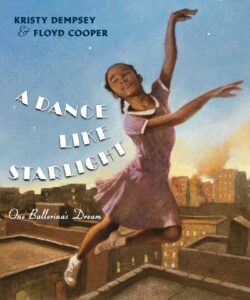 The Hula Hoopin’ Queen by Thelma Lynne Godin, illustrated Vanessa Brantley-Newton, ISBN: 9781600608469
The Hula Hoopin’ Queen by Thelma Lynne Godin, illustrated Vanessa Brantley-Newton, ISBN: 9781600608469
My Hands Sing the Blues: Romare Bearden’s Childhood Journey by Jeanne Walker Harvey, illustrated by Elizabeth Zunon, ISBN: 9780761458104
My Friend Maya Loves to Dance by Cheryl Willis Hudson, illustrated by Eric Velasquez, ISBN: 9780810983281
Lullaby (For a Black Mother) by Langston Hughes, illustrated Sean Qualls, ISBN: 9780547362656
Goal! by Mina Javaherbin, illustrated by A.G. Ford, ISBN: 9780763658229
All Different Now: Juneteenth, the First Day of Freedom by Angela Johnson, illustrated by E.B. Lewis, ISBN: 9780689873768
The Boy Who Harnessed the Wind by William Kamkwamba and Bryan Mealer, illustrated by Elizabeth Zunon, ISBN: 9780803735118
We Shall Overcome: The Story of a Song by Debbie Levy, illustrated by Vanessa Brantley-Newton, ISBN: 9781423119548
Hope’s Gift by Kelly Starling Lyons, illustrated Don Tate, ISBN: 9780399160011
Tea Cakes for Tosh by Kelly Starling Lyons, illustrated by E.B. Lewis, ISBN: 9780399252136
Ellen’s Broom by Kelly Starling Lyons, illustrated by Daniel Minter, ISBN: 9780399250033
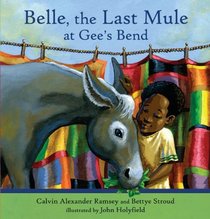 Every Little Thing: Based on the Song ‘Three Little Birds’ by Bob Marley and Cedella Marley, illustrated by Vanessa Brantley-Newton, ISBN: 9781452106977
Every Little Thing: Based on the Song ‘Three Little Birds’ by Bob Marley and Cedella Marley, illustrated by Vanessa Brantley-Newton, ISBN: 9781452106977
One Love by Cedella Marley, Vanessa Brantley-Newton, ISBN: 9781452102245
These Hands by Margaret H. Mason, illustrated by Floyd Cooper, ISBN: 9780547215662
Busing Brewster by Richard Michelson, illustrated by R.G. Roth, ISBN: 9780375833342
H.O.R.S.E.: A Game of Basketball and Imagination by Christopher Myers, ISBN: 9781606842188
My Brother Charlie by Holly Robinson Peete & Ryan Elizabeth Peete, illustrated by Shane W. Evans, ISBN: 9780545094665
Belle, the Last Mule at Gee’s Bend: A Civil Rights Story by Calvin Alexander Ramsey, Bettye Stroud, Bettye, and John Holyfield, ISBN: 9780763640583
Ruth and the Green Book by Calvin Alexander Ramsey, illustrated by Floyd Cooper, ISBN: 9780761352556
Under the Same Sun by Sharon Robinson, illustrated by A.G. Ford, ISBN: 9780545166720
Me and Momma and Big John by Mara Rockliff, illustrated by William Low, ISBN: 9780763643591
Little Melba and Her Big Trombone by Katheryn Russell-Brown, illustrated by Frank Morrison, ISBN: 9781600608988
I Got the Rhythm by Connie Schofield-Morrison, illustrated by Frank Morrison, ISBN: 9781619631786
 In the Land of Milk and Honey by Joyce Carol Thomas, illustrated by Floyd Cooper, ISBN: 9780060253837
In the Land of Milk and Honey by Joyce Carol Thomas, illustrated by Floyd Cooper, ISBN: 9780060253837
As Fast As Words Could Fly by Pamela M. Tuck, illustrated by Eric Velasquez, ISBN: 9781600603488
Grandma’s Gift by Eric Velasquez, ISBN: 9780802720825
Freedom Song: The Story of Henry “Box” Brown by Sally M. Walker, illustrated by Sean Qualls, ISBN: 9780060583101
Sugar Hill: Harlem’s Historic Neighborhood by Carole Boston Weatherford, illustrated by R. Gregory Christie, ISBN: 9780807576502
A Beach Tail by Karen Lynn Williams, illustrated by Floyd Cooper, ISBN: 9781590787120
Jazz Age Josephine by Jonah Winter, illustrated by Marjorie Priceman, ISBN: 9781416961239
This Is the Rope: A Story from the Great Migration by Jacqueline Woodson, Jacqueline, illustrated by James Ransome, ISBN: 9780399239861
Pecan Pie Baby by Jacqueline Woodson, illustrated by Sophie Blackall, ISBN: 9780399239878
Early Chapter Books
 Dog Days by Karen English, illustrated by Laura Freeman, ISBN: 9780547970448
Dog Days by Karen English, illustrated by Laura Freeman, ISBN: 9780547970448
Election Madness by Karen English, illustrated by Laura Freeman, ISBN: 9780547850719
Skateboard Party by Karen English, illustrated by Laura Freeman, ISBN: 9780544283060
Birthday Blues by Karen English, illustrated by Laura Freeman, ISBN: 9780547248936
Nikki and Deja by Karen English, illustrated by Laura Freeman, ISBN: 9780547133621
Substitute Trouble by Karen English, illustrated by Laura Freeman, ISBN: 9780544223882
Keena Ford and the Secret Journal Mix-Up by Melissa Thomson, illustrated by Frank Morrison, ISBN: 9780142419373
Keena Ford and the Field Trip Mix-Up by Melissa Thomson, illustrated by Frank Morrison, ISBN: 9780142415726
EllRay Jakes and the Beanstalk by Sally Warner, illustrated by Brian Biggs, ISBN: 9780670784998
EllRay Jakes the Dragon Slayer! by Sally Warner, illustrated by Brian Biggs, ISBN: 9780670784974
EllRay Jakes Walks the Plank! by Sally Warner, illustrated by Jamie Harper, ISBN: 9780670063062
EllRay Jakes Is a Rock Star by Sally Warner, illustrated by Jamie Harper, ISBN: 9780670011582
EllRay Jakes is Not a Chicken! by Sally Warner, illustrated by Jamie Harper, ISBN: 9780670062430
Ellray Jakes Rocks the Holidays! by Sally Warner, illustrated by Brian Biggs, ISBN: 9780451469090
Ellray Jakes Is Magic! by Sally Warner, illustrated by Brian Biggs, ISBN: 9780670785001
Middle Grade Fiction
 Sasquatch in the Paint by Kareem Abdul-Jabbar and Raymond Obstfeld, ISBN: 9781423178705
Sasquatch in the Paint by Kareem Abdul-Jabbar and Raymond Obstfeld, ISBN: 9781423178705
The Crossover by Kwame Alexander, ISBN: 9780544107717
How Lamar’s Bad Prank Won a Bubba-Sized Trophy by Crystal Allen, ISBN: 9780061992728
Hold Fast by Blue Balliett, ISBN: 9780545299886
The Zero Degree Zombie Zone by Patrik Henry Bass, illustrated by Jerry Craft, ISBN: 9780545132107
Zora and Me by Victoria Bond, Victoria and T.R. Simon, ISBN: 9780763643003
Kinda Like Brothers by Coe Booth, ISBN: 9780545224963
Serafina’s Promise by Ann E. Burg, ISBN: 9780545535649
Riding on Duke’s Train by Mick Carlon, ISBN: 9781935248064
Etched in Clay: The Life of Dave, Enslaved Potter and Poet by Andrea Cheng, ISBN: 9781600604515
The Madman of Piney Woods by Christopher Paul Curtis, ISBN: 9780545156646
Africa Is My Home: A Child of the Amistad by Monica Edinger, illustrated by Robert Byrd, ISBN: 9780763650384
Unstoppable Octobia May by Sharon Flake, ISBN: 9780545609609
Winter Sky by Patricia Reilly Giff, ISBN: 9780375838927
The Perfect Place by Teresa E. Harris, ISBN: 9780547255194
Buddy by M.H. Herlong, ISBN: 9780142425442
 The Great Greene Heist by Varian Johnson, ISBN: 9780545525527
The Great Greene Heist by Varian Johnson, ISBN: 9780545525527
Upside Down in the Middle of Nowhere by Julie T. Lamana, ISBN: 9781452124568
Nightingale’s Nest by Nikki Loftin, ISBN: 9781595145468
True Legend by Mike Lupica, ISBN: 9780399252273
The Sittin’ Up by Sheila P. Moses, ISBN: 9780399257230
Ghetto Cowboy by G. Neri, illustrated by Jesse Joshua Watson, ISBN: 9780763649227
Ninth Ward by Jewell Parker Rhodes, ISBN: 9780316043083
8th Grade Superzero by Olugbemisola Rhuday-Perkovich, ISBN: 9780545097253
The Other Side of Free by Krista Russell, ISBN: 9781561457106
Eddie Red Undercover: Mystery on Museum Mile by Marcia Wells, illustrated by Marcos Calo, ISBN: 9780544238336
One Crazy Summer by Rita Williams-Garcia, ISBN: 9780060760885
P.S. Be Eleven by Rita Williams-Garcia, ISBN: 9780061938627
The Blossoming Universe of Violet Diamond by Brenda Woods, ISBN: 9780399257148
Crow by Barbara Wright, ISBN: 9780375873676
Non-Fiction
What Color Is My World?: The Lost History of African-American Inventors by Kareem Abdul-Jabbar, Raymond Obstfeld, and Ben Boos, illustrated by A.G. Ford, ISBN: 9780763645649
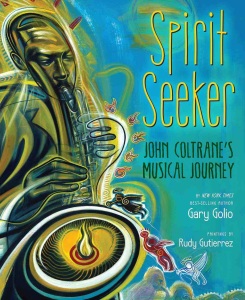 A Splash of Red: The Life and Art of Horace Pippin by Jen Bryant, illustrated by Melissa Sweet, ISBN: 9780375867125
A Splash of Red: The Life and Art of Horace Pippin by Jen Bryant, illustrated by Melissa Sweet, ISBN: 9780375867125
The Cart That Carried Martin by Eve Bunting, illustrated by Don Tate, ISBN: 9781580893879
Words Set Me Free: The Story of Young Frederick Douglass by Lesa Cline-Ransome, illustrated by James E. Ransome, ISBN: 9781416959038
Ballerina Dreams: From Orphan to Ballerina by Michaela Deprince, Michaela and Elaine Deprince, illustrated by Frank Morrison, ISBN: 9780385755160
Spirit Seeker: John Coltrane’s Musical Journey by Gary Golio, illustrated by Rudy Gutierrez, ISBN: 9780547239941
Jimi: Sounds Like a Rainbow: A Story of the Young Jimi Hendrix by Gary Golio, illustrated by Javaka Steptoe, ISBN: 9780618852796
I Lay My Stitches Down: Poems of American Slavery by Cynthia Grady, illustrated by Michele Wood, ISBN: 9780802853868
The Great Migration: Journey to the North by Eloise Greenfield, illustrated by Jan Spivey Gilchrist, ISBN: 9780061259210
When the Beat Was Born: DJ Kool Herc and the Creation of Hip Hop by Laban Carrick Hill, illustrated by Theodore Taylor III, ISBN: 9781596435407
Dave the Potter: Artist, Poet, Slave by Laban Carrick Hill, illustrated by Bryan Collier, ISBN: 9780316107310
I, Too, Am America by Langston Hughes, illustrated by Bryan Collier, ISBN: 9781442420083
The Girl from the Tar Paper School: Barbara Rose Johns and the Advent of the Civil Rights Movement by Teri Kanefield, ISBN: 9781419707964
Queen of the Track: Alice Coachman: Olympic High-Jump Champion by Heather Lang, illustrated by Floyd Cooper, ISBN: 9781590788509
 We’ve Got a Job: The 1963 Birmingham Children’s March by Cynthia Levinson, ISBN: 9781561456277
We’ve Got a Job: The 1963 Birmingham Children’s March by Cynthia Levinson, ISBN: 9781561456277
When Thunder Comes: Poems for Civil Rights Leaders by J. Patrick Lewis, illustrated by Various, ISBN: 9781452101194
Touch the Sky: Alice Coachman, Olympic High Jumper by Ann Malaspina, illustrated by Eric Velasquez, ISBN: 9780807580356
Farmer Will Allen and the Growing Table by Jacqueline Briggs Martin and Will Allen, illustrated by Eric-Shabazz Larkin, ISBN: 9780983661535
Nelson Mandela by Kadir Nelson, ISBN: 9780061783746
Heart and Soul: The Story of America and African Americans
by Kadir Nelson, ISBN: 9780061730740
Skit-Scat Raggedy Cat: Ella Fitzgerald by Roxane Orgill, illustrated by Sean Qualls, ISBN: 9780763664596
Martin & Mahalia: His Words – Her Song by Andrea Davis Pinkney, Andrea Davis, illustrated by J. Brian Pinkney, ISBN: 9780316070133
Hand in Hand: Ten Black Men Who Changed America by Andrea Davis Pinkney, illustrated by J. Brian Pinkney, ISBN: 9781423142577
Sit-In: How Four Friends Stood Up by Sitting Down by Andrea Davis Pinkney, illustrated by J. Brian Pinkney, ISBN: 9780316070164
Josephine: The Dazzling Life of Josephine Baker by Patricia Hruby Powell, illustrated by Christian Robinson, ISBN: 9781452103143
Jackie Robinson: American Hero by Sharon Robinson, ISBN: 9780545569156
Something to Prove: The Great Satchel Paige Vs. Rookie Joe Dimaggio by Robert Skead, illustrated by Floyd Cooper, ISBN: 9780761366195
 Brick by Brick by Charles R. Smith Jr., illustrated by Floyd Cooper, ISBN: 9780061920820
Brick by Brick by Charles R. Smith Jr., illustrated by Floyd Cooper, ISBN: 9780061920820
Stars in the Shadows: The Negro League All-Star Game of 1934
by Charles R. Smith Jr., illustrated by Frank Morrison, ISBN: 9780689866388
Black Jack: The Ballad of Jack Johnson by Charles R. Smith Jr., illustrated by Shane W. Evans, ISBN: 9781596434738
Courage Has No Color: The True Story of the Triple Nickels: America’s First Black Paratroopers by Tanya Lee Stone, ISBN: 9780763651176
It Jes’ Happened: When Bill Traylor Started to Draw by Don Tate, illustrated by R. Gregory Christie, ISBN: 9781600602603
She Loved Baseball: The Effa Manley Story by Audrey Vernick, illustrated by Don Tate, ISBN: 9780061349201
My Uncle Martin’s Words for America: Martin Luther King Jr.’s Niece Tells How He Made a Difference by Angela Farris Watkins, illustrated by Eric Velasquez, ISBN: 9781419700224
My Uncle Martin’s Big Heart by Angela Farris Watkins, Angela illustrated by Eric Velasquez, ISBN: 9780810989757
Brown Girl Dreaming by Jacqueline Woodson, ISBN: 9780399252518

Jazz Age Josephine
By Jonah Winter; illustrated by Marjorie Priceman
Recently looked up an overview of National African American History Month on the Law Library website of the Library of Congress.
It states that it “celebrates the contributions that African Americans have made to American History in their struggle for freedom and equality and deepens our understanding of our Nation’s history.”
I thought that I would perhaps focus this contribution on some of the astounding African American women in the arts.
Not that those men and women involved in the initial struggles for equality are to be short changed this month. They certainly paved the way for the recognition of people of color in the arts – and they are many and multi talented!
But I wanted to mention two women this month; namely jazz singing and performing giant Josephine Baker, and the picture book that brings her to abundant life called “Jazz Age Josephine”.
And ballerina Misty Copeland, literally flies through hard knocks in life with both talent and grace in this award winning picture book, illustrated by Christopher Myers, called “Firebird.” She is the first African American soloist at the American Ballet Theatre! And illustrator, Christopher Myers recently won the Coretta Scott King Illustrator Book” for this Penguin Young Readers title!
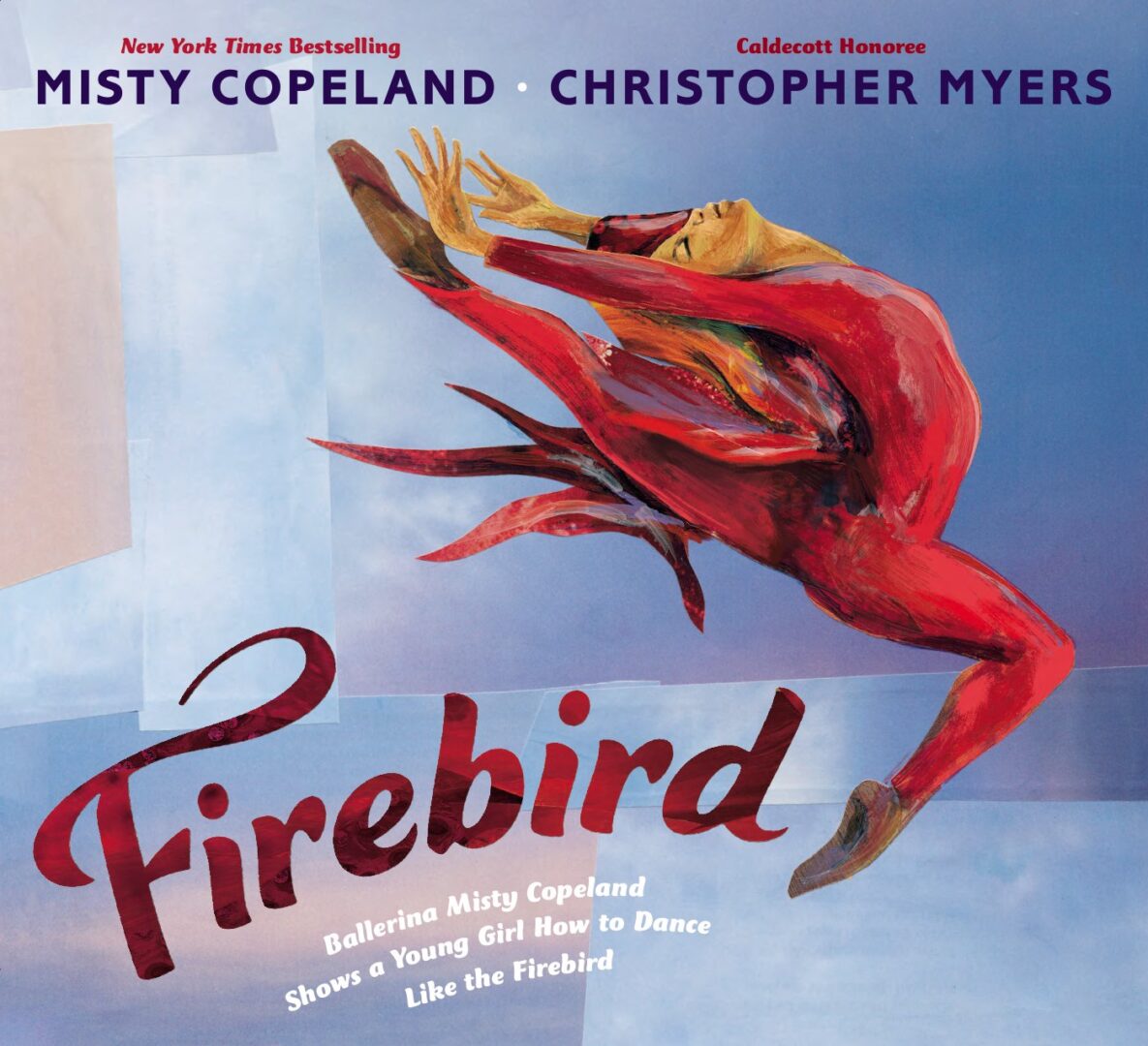
And now to the dream of a young Miss Baker!
If we stand on the shoulders of the people that came before us, that is certainly true of a young Josephine Baker growing up in wrenching poverty in St. Louis. But Josephine’s granny tells her “Someday you’re gonna be a princess.” And she had the courage to dream those words to a truth all her own.
Tenacity, humor, talent and timing converge in the life of Josephine Baker to propel her to New York where she initially slept on a park bench.
From the chorus line to the heights of the Jazz Age in 1925, she travels to Paris where she becomes the toast of the town.
Gay Paree!
Josephine!
Here’s an act
they’ve never seen!
Dances like the Shimmy, Mess Around, Shake and the Charleston, make Josephine the rage when her great act includes outrageous costumes and a voice to boot.
Her fairy tale life is brought to perfection with strong punched up color art as strong and resilient as Ms. Baker herself. The art is from two time Caldecott honoree, Marjorie Priceman.
I didn’t know that Ms. Baker was there on the podium the day that Martin Luther King, Jr. gave his “I Have a Dream” speech! Civil rights activism was also a big part of her life.
She and he both dreamed of a better life for themselves and others, and it is a testament to what is possible with a dream, a large measure of faith in the dream, and a resilience that doesn’t allow it to die.
Great messages for young readers to hear that are growing up today!

By: Samantha McGinnis,
on 2/3/2015
Blog:
First Book
(
Login to Add to MyJacketFlap)
JacketFlap tags:
Book lists,
Books & Reading,
Black history month,
African-American history,
Bad News for Outlaws,
Laurie Halse Anderson,
Kathleen Krull,
Chains,
Maya Angelou,
Bryan Collier,
Doreen Rappaport,
Martin's Big Words,
I Know Why The Caged Bird Sings,
Vaunda Micheaux Nelson,
Wilma Unlimited,
Add a tag
February is Black History Month and to celebrate we’re sharing five of our favorite books that honor the history and legacy of African Americans.
If you work with kids in need, you can find these and other great titles to celebrate Black History Month on the First Book Marketplace.
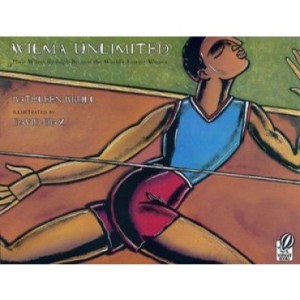 Wilma Unlimited: How Wilma Rudolph Became the World’s Fastest Woman by Kathleen Krull
Wilma Unlimited: How Wilma Rudolph Became the World’s Fastest Woman by Kathleen Krull
Before Wilma Rudolph was five years old, polio had paralyzed her left leg. Everyone said she would never walk again. But Wilma refused to believe it. Not only would she walk again, she vowed, she’d run. And she did run—all the way to the Olympics, where she became the first American woman to earn three gold medals in a single olympiad. This dramatic and inspiring true story is illustrated in bold watercolor and acrylic paintings by Caldecott Medal-winning artist David Diaz.
 Martin’s Big Words: The Life of Dr. Martin Luther King, Jr. by Doreen Rappaport and Bryan Collier
Martin’s Big Words: The Life of Dr. Martin Luther King, Jr. by Doreen Rappaport and Bryan Collier
This picture book biography of Dr. Martin Luther King, Jr. brings his life and the profound nature of his message to young children through his own words. Martin Luther King, Jr., was one of the most influential and gifted speakers of all time. Doreen Rappaport uses quotes from some of his most beloved speeches to tell the story of his life and his work in a simple, direct way. Bryan Collier’s stunning collage art combines remarkable watercolor paintings with vibrant patterns and textures.
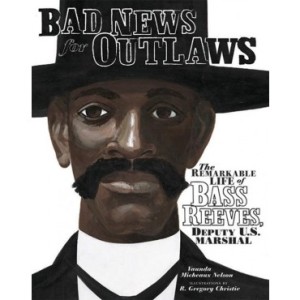 Bad News for Outlaws: The Remarkable Life of Bass Reeves, Deputy U. S. Marshal by Vaunda Micheaux Nelson
Bad News for Outlaws: The Remarkable Life of Bass Reeves, Deputy U. S. Marshal by Vaunda Micheaux Nelson
Sitting tall in the saddle, with a wide-brimmed black hat and twin Colt pistols on his belt, Bass Reeves seemed bigger than life. Outlaws feared him. Law-abiding citizens respected him. As a peace officer, he was cunning and fearless. When a lawbreaker heard Bass Reeves had his warrant, he knew it was the end of the trail, because Bass always got his man, dead or alive. Born into slavery in 1838, Bass had a hard and violent life, but he also had a strong sense of right and wrong that others admired. When Judge Isaac Parker tried to bring law and order to the lawless Indian Territories, he chose Bass to be a deputy U.S. Marshall. Bass would quickly prove a smart choice. The story of Bass Reeves is the story of a remarkable African American and a remarkable hero of the Old West.
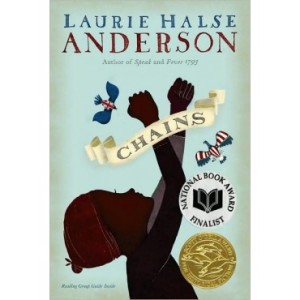 Chains by Laurie Halse Anderson
Chains by Laurie Halse Anderson
As the Revolutionary War begins, thirteen-year-old Isabel wages her own fight…for freedom. Promised freedom upon the death of their owner, she and her sister, Ruth, in a cruel twist of fate become the property of a malicious New York City couple, the Locktons, who have no sympathy for the American Revolution and even less for Ruth and Isabel. When Isabel meets Curzon, a slave with ties to the Patriots, he encourages her to spy on her owners, who know details of British plans for invasion. She is reluctant at first, but when the unthinkable happens to Ruth, Isabel realizes her loyalty is available to the bidder who can provide her with freedom.
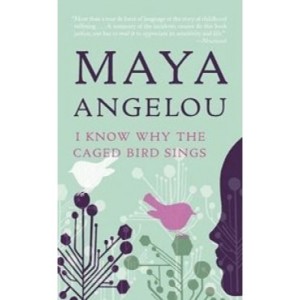 I Know Why The Caged Bird Sings by Maya Angelou
I Know Why The Caged Bird Sings by Maya Angelou
Sent by their mother to live with their devout, self-sufficient grandmother in a small Southern town, Maya and her brother, Bailey, endure the ache of abandonment and the prejudice of the local “powhitetrash.” At eight years old and back at her mother’s side in St. Louis, Maya is attacked by a man many times her age–and has to live with the consequences for a lifetime. Years later, in San Francisco, Maya learns about love for herself and the kindness of others, her own strong spirit, and the ideas of great authors (“I met and fell in love with William Shakespeare”) will allow her to be free instead of imprisoned.
*Book descriptions shown are publisher descriptions and have not been written by First Book.
The post 5 Books to Celebrate Black History Month appeared first on First Book Blog.


By: Liz,
on 1/19/2015
Blog:
Liz's Book Snuggery
(
Login to Add to MyJacketFlap)
JacketFlap tags:
Classics,
Picture Books,
Read Aloud,
Floyd Cooper,
African-American History,
Aaron Reynolds,
Back of the Bus,
3-5,
5-8,
Frends,
Add a tag
Back of the Bus
By Aaron Reynolds, illustrated by Floyd Cooper
It may seem strange perhaps to post a book on Rosa Parks’ act of defiance on December 1, 1955, to honor Martin Luther King on his national holiday, but as so many other events in history, they are interlinked. When Rosa Parks defied the Montgomery, Alabama city code that required them to not only sit in a separate section of the city buses, but to give up their seats if white passengers boarding, could not find seating in the all white section! Young readers need to be reminded how life was for many of our citizens in the not too distant past. And that is what “Back of the Bus” helps to achieve in telling the Rosa Parks event through the eyes of a fictional black child and his mother seated on the bus that day.
Aaron Reynolds fills his book with small events to portray the small boy as just a child riding the bus with his mom as an everyday event in his life; a day just like any other except it turned out to be a defining moment in history he chances upon. He takes out his bright, shiny marble, a tiger’s eye, and rolls it. As the bus slows, it follows the law of gravity away from him and rolls right into the hand of Rosa Parks who rolls it back with a grin. More passengers get on.
Then it happens. Mr. Blake, the driver growls out, “Y’all gotta move, now.” Some people do get up and move, but the bus is at a dead standstill. Somebody is speaking up. But the words of the bus driver carry to the back of the bus, “I’m gonna call the police, now.”
Whispers fill the halted bus and the boy can see from his perch at the back of the bus that the speaker was Rosa Parks.
She doesn’t belong up front like that,
and them folks know it.
But she’s sittin’ right there,
her eyes all fierce like a lightnin’ storm,
like maybe she does belong up there.
And I start thinkin’ maybe she does too.
Words may be instructive as we parents know, but I still think example is the strongest teacher. And in Ms. Parks her subsequent arrest and fine because of the violation of Montgomery’s city code was a watershed event.
The boy’s mother placates him with the words, “Tomorrow all this’ll be forgot.” Though his mother says the words, he too takes note of the new “lightning” storm” in her eyes. And instead of feeling afraid, he feels a new strength.
Taking out his tiger’s eye marble from the tightly closed fist, instead he holds it up to the light with a new pride. I love the illustrations that seem a bit out of focus and muted until Rosa Parks takes her stand. The defining lines and shapes seem dim with everything hazy and unclear, including the people on the bus. Mr. Cooper’s artistic technique changes with Ms. Parks’ refusal. Images are sharp and clear. People, including the young boy’s mother are drawn with clear and delineated thoughtful feelings of emotion at what has happened. Art and narrative blend beautifully to display the change that is afoot.
Where does Martin Luther King’s life intersect with Rosa Parks? Following this event, the Mt. Zion Church of Montgomery spurs the formation of the Montgomery Improvement Association, lead by Martin Luther King. Their initial goal is to effect change starting with the very segregation bus code effecting Ms. Parks. The MIA organizes a very successful boycott of the buses for 382 days with some 40,000 black riders cobbling together alternate means of transportation to get to work. They included walking, carpooling, riding in African-American operated cabs. Martin Luther King’s home was attacked in the ensuing violence the boycott began.
Rosa Parks single act of defiance with the words, “I don’t think I should have to stand up,” was the catalyst for change. Books and the ideas they foster have done the same thing for people with each turn of the page. And for your young readers, “Back of the Bus” may not only provide a look back in history at a single and seminal act of defiance that changed an unjust law, but a model for a way to stand up for something they believe in when the still, small voice in each of us tells us to do so.
In this well researched book, author Susan Goldman Rubin takes us back to 1964 Mississippi, when the nation was shocked by the disappearance--and discovery of the murder--of three Freedom Summer workers. The Freedom Summer workers were courageous young people, mostly college students from Northern schools, who travelled to Mississippi, living with black families, trying to register black voters and opening Freedom Schools to educate black children and their parents.
Rubin follows the story chronologically, focusing on specific anecdotes which make the story more immediate for young people. The book is greatly enriched by personal interviews Rubin was able to do with participants, as well as extensive use of original source material. In addition, the book is handsomely illustrated with archival photographs and drawings. Extensive back matter includes information on the trial of the main organizer of the murders, who did not face justice until 2005. Information is provided on additional resources; there is also a timeline, source notes, reproduction of original documents, a detailed bibliography, and an index. This is an excellent nonfiction book for the new common core curriculum or for anyone interested in the history of the civil rights movement in the United States. Recommended for students in grades 5 and up.

By: Liz,
on 3/12/2014
Blog:
Liz's Book Snuggery
(
Login to Add to MyJacketFlap)
JacketFlap tags:
Picture Books,
African-American History,
Women's History,
3-5,
5-8,
Way Back Wednesday,
Marybeth Lorbiecki,
Sister Anne’s Hands,
Wendy Bopp,
Add a tag
Sister Anne’s Hands
By Marybeth Lorbiecki; illustrated by Wendy Bopp
March is Women’s History Month and March 8th through 14th is the first ever National Catholic Sisters Week that is intended to celebrate the generations of sisters who have taught in schools, served in nursing homes, orphanages and hospitals throughout the United States. Generally they were the glue that, in many ways, held the institution of the Catholic Church together seamlessly. And they did this all with a quiet determination and dedication with little recognition other than the conviction that their lives and the thousands they touched, were a testament to the faith they believed in. Sadly their numbers are dwindling as young people choose other avenues of service.
All of this put me in mind of a wonderful picture book I remember called, “Sister Anne’s Hands” by Marybeth Lorbiecki with illustrations by Wendy Bopp.
Sister Anne is an African-American sister teaching in a parochial school in the 60’s. Her teaching and storytelling methods are inventive and interesting as Wendy Bopp’s illustrations portray Sister Anne’s students held in rapt attention when she speaks. Just imagine how hard that was to pull off with 50 something children in an average class at that time! The picture book’s story is told through the eyes of young Anna, a student in Sister Anne’s class who is confused when she overhears her parents say, “I don’t know how a woman of her color is going to survive.”
Sister Anne confronts the concrete meaning of that overheard phrase when a paper airplane sails through the air in her classroom with the following words written on it:
Roses are red.
Violets are blue.
Don’t let Sister Anne
Get any black on you.
The racial slur from a young unformed mind, obviously influenced by others, has Sister Anne react with a calm demeanor as she says she “needs quiet time to think about this.”
And Sister Anne opts to react to the racial discrimination in her young charges by informing them of her own experiences and heritage that causes some parents to withdraw their children from the class. But the children who remain are the fortunate ones. They are the recipients of the wisdom and talented teaching of a wonderful young woman who has an innate love for the young minds that come into her sphere for one special year. Young Anna in Sister Anne’s Hands and it seems, the author herself are both lucky enough to have come under the influence of a dedicated sister whose persona is only symbolic of the thousands like her. Wendy Bopp’s beautiful art work coupled with Ms. Lorbiecki’s view on a very contemporary issue of the 60’s is beautifully executed.
And in that same vein, this book put me in mind of a sister I once met that recently passed away. She became the teacher of a young African-American student named Clarence Thomas; the very same Clarence Thomas that went on to become a Supreme Court Justice. Her dedication to the teaching of young African American students at a time in our country’s history when it was, to say the least, frowned upon, was both heartfelt and heroic. This sister, and others of her order put the education of ALL children first. Her core belief, put into action, was that every student deserved to have an equal chance at reaching his or her goals and her entire life was in the service of that belief.
So to ALL the Sister Annes of this world, and especially to the sister that I just mentioned, “Thank you! For the world will not see your like again.” And by the way, I had a Sister Anne-like teacher too!
Recommended for ages 5 and up.
Amy Novesky's most recent picture book,
Mister and Lady Day, an ode to jazz great Billie Holiday and her pet dogs, just arrived at my library in time for Women's History Month.
This is Amy's fourth book on prominent female figures in cultural history; she has also penned
Me, Frida (on artist Frida Khalo),
Georgia in Hawaii (on artist Georgia O'Keefe),
Imogen (on photographer Imogen Cunningham). She is currently working on a picture book on sculptor Louise Bourgeois.
Billie Holiday's tragic life. which included working as a prostitute, living in a workhouse with her mother, drug addiction, a prison sentence, and more, might not seem like a natural fit for a picture book for young children, and indeed, this side of Holiday's life does not appear in Novesky's book. Novesky focused instead on Holiday's love for her many dogs, and in particular for her boxer named Mister. Love for a dog, of course, is a theme that children identify easily with, as do many adults (OK, I'm a sucker for a good dog story).
We first meet Billie Holiday as a young girl, dreaming of being a star, singing on a borrowed gramophone. Illustrator
Vanessa Brantley Newton, whose charming illustrations are done with gouache and charcoal with collage elements, depicts Billie in a beautiful setting on a fancy chair, dressed up with a bow in her hair (perhaps a bit fanciful given the realities of her childhood!). The next spread shows her already a star, the great Lady Day. (Illustrated 2-page spreads from the book can be seen on
Novesky's website). Novesky introduces a note of melancholy in the text from the beginning, by explaining that even stars need someone to listen to them, and that's the role Lady Day's dogs played. We meet her small dogs, chihuahuas Pepe and Chiquita, her big dogs (a Great Dane named Gypsy, and finally her favorite dog of all, Mister, who we see in a fabulous illustration, walking with Billie on a leash wearing matching mink coats. Instead of a sidewalk, they are walking on a piano keyboard, with the buildings of New York in the background. Mister had the life of a star himself; he was so pampered he got to eat steak while she was performing in glamorous clubs, and he waited for her while she performed, even serving to keep eager fans at bay.
Novesky tells young readers that "Lady got into trouble. She had to leave home for a year and a day. And Mister couldn't come." In an afterword, she explains that Billie Holiday was in fact in jail during that time for drug possession. When she returned, Mister was there to welcome her, and even accompanied her to a grand concert at New York's Carnegie Hall. The story ends on a hopeful note, with Billie singing her heart out, and Mister listening in the wings.
An author's note gives some more background on Holiday's life, appropriately omitting some of the uglier facts, and provides additional sources and a web resource.
There's no CD with the book, but readers could easily find CD's of Holiday's unique singing style at the library or on YouTube, which would enrich the story.
This is a moving yet charming book about a difficult subject, and could be integrated into units on Black History Month, Women's History Month, or jazz.

By:
Betsy Bird,
on 1/1/2014
Blog:
A Fuse #8 Production
(
Login to Add to MyJacketFlap)
JacketFlap tags:
middle grade historical fiction,
multicultural middle grade,
Krista Russell,
African-American kids,
Best Books of 2013,
2013 middle grade fiction,
2013 historical fiction,
African-American books,
multicultural,
Reviews,
middle grade fiction,
slavery,
multicultural fiction,
African-American history,
Add a tag
 The Other Side of Free
The Other Side of Free
By Krista Russell
Peachtree Publishers
$16.95
ISBN: 978-1-56145-710-6
Ages 9-12
On shelves now
Have you ever read the adult book How I Became a Famous Novelist? Bear with me for a second here, I know what I’m doing. You see, in the title the author decides that he wants to become a New York Times bestseller. In the course of his quest he runs across a variety of different authors who embody a variety of different types of novels. His own aunt decides she wants to be a children’s author and sets about doing so by writing a work of historical middle grade fiction. The book is about a girl living in Colonial America who wants to be a cooper. In only a page or two author Steve Hely puts his finger on a whole swath of children’s books that drive librarians like myself mildly mad. They find familiar situations and alter very little aside from location and exact year to tell their tales. The result is an increasing wariness on my part to read any works of historical fiction, for fear that you’ll see the same dang story again and again. With all this in mind you can imagine the relief with which I read Krista Russell’sThe Other Side of Free. Not only is the setting utterly original (not to mention unforgettable) but the characters don’t fill the same little roles you’ll see in other children’s novels. If you have kids that have tired of the same old, same old, The Other Side of Free will give them something they haven’t seen before.
We’ve all heard of how slaves would escape to the North when they wished to escape for good. But travel a bit farther back in time to the early 18th century and the tale is a little different. At that point in history slaves didn’t flee north but south to Spain’s territories. There, the Spanish king promised freedom for those slaves that swore fidelity to the Spanish crown and fought on his behalf against the English. 13-year-old Jem is one of those escaped slaves, but his life at Fort Mose is hardly stimulating. Kept under the yoke of a hard woman named Phaedra, Jem longs to fight for the king and to join in the battles. But when at last the fighting comes to him, it isn’t at all what he thought it would be. A Bibliography of sources appears at the end of the book.
There are big themes at work here. What freedom is worth to an individual if it means yoking yourself to someone else. If militia work really does mean freedom, or just slavery of a new kind. Jem himself chafes under the hand of Phaedra, though I think it would be obvious, even to a kid reader, that he’s immature in more than one way. But with all that said, it’s the lighter moments that make the book for me. Omen the owl is a notable example of a detail that makes the book more than just a work of history. In this story Jem adopts an owlet and raises it as his own. In your standard generic fare the owl would be a beloved friend and companion, possibly ultimately dying for Jem in a heroic scene reminiscent of Hedwig’s death. Instead, the owl is hell on wings. A nasty, chicken-snatching, very real and wild creature that is, nonetheless, beloved of our hero. Again, expectations are upset. I love it when that happens.
I liked the individual lines Russell used to dot the text as well. For example, in an early character note about Phaedra the book describes her construction of a grass basket. “Her fingers snatched at the fronds again and again, until each strip was bent and shaped to her will.” It’s worth noting that it’s Jem who is saying this about her. Almost the whole book is told through his own perspective and, as such, may not be entirely trustworthy. He has his own prejudices to fight, after all. I also like Russell’s everyday descriptions. “Adine handed each man a jug of water. They drank until it ran down their faces, leaving tails like gray veins down their throats.” Beautifully put.
Honestly it would make a heckuva stage play. The settings are necessarily limited, with Jem spending most of his time in Fort Mose and the rest of it in St. Augustine. Not having been familiar with the people of Fort Mose before, I found myself incredibly anxious to learn what became of them. Russell ends the book on a hopeful note, but you cannot help but wonder. If there were freed slaves in Florida in 1739 then what happened when that state became the property of the English in 1763? All Russell says at that time is “At this time, the free Africans of Mose relocated to Cuba.” Kids will just have to extrapolate a happy ending for Jem and his friends from that.
A great work of historical fiction does a number of things. It introduces you to unfamiliar places and people. It establishes a kind of empathy for those people that you otherwise would never have met. It puts you in their shoes, if only for a moment. And most of all, it surprises you. Upsets your expectations, maybe. For most kids in America, the history of slavery is short and sweet. Slaves came from Africa. They escaped North. They were freed thanks in part to the Civil War. What more is there is say or to learn aside from some vague info on the Underground Railroad? Russell challenges these assumptions, bringing us a tale that is wholly new, but filled with facts. If the rote and familiar don’t suit you and you want a book that travels over new ground, you can hardly do better than The Other Side of Free. Smart and original, it’s a one-of-a-kind novel. Hardly the kind of thing you run across every day.
On shelves now.
Source: Galley sent from publisher for review.
Notes on the Cover: I don’t want to sound ungrateful. I can see what Peachtree was going for here. In this image you get the dense canopy of a Floridian forest. You even have a black boy on the cover (albeit completely turned away from the viewer, which is kind of a cheat). But all in all, whether it’s the art or the design or the color palette, this book is not the most visually appealing little number I’ve seen in all my livelong days. I’m having a devil of a time getting folks to pick it up of their own accord. One hopes that if it goes to paperback someday, maybe it’ll be given a cover worthy of its content.
Like This? Then Try:

Recommended for ages 7-12.Candlewick has recently reissued in beautiful full-color paperback editions several biographies of famous African-American women by Kathryn Lasky. Earlier this month I reviewed
Vision of Beauty: The Story of Sarah Breedlove Walker. In
A Voice of Her Own, Lasky shares the story of an equally extraordinary woman, Phillis Wheatley, known as the first black woman poet in America.
Lasky begins her book as a young girl is kidnapped from Africa and sold into slavery in America in 1761. Through the girl's eyes, Lasky describes the harrowing journey from the west coast of Africa. A powerful illustration, painted in acrylics, shows a terrified young girl huddled in the hold of the ship. Upon arrival, she is purchased at a Boston slave market by the Wheatley family and given the name Phillis. When we next meet Phillis, we learn that she has become no ordinary slave. Mrs. Wheatley, realizing quickly how bright her new young slave was, decided to teach her to read and write, a sort of social experiment to see if an African could learn and understand the Bible. While this sort of instruction was not illegal as it was in the South, it was nevertheless never done.
Phillis proved to be such an able student that she progressed beyond English to Latin and Greek, geography and mathematics--this at a time when few white women were offered this sort of education, and only the elite among white men. Phillis was especially attracted to poetry, and had her first poem published when she was only fourteen years old. Phillis became a celebrity in Boston, and was trotted out by her mistress to all the finest houses in town as a sort of curiosity.
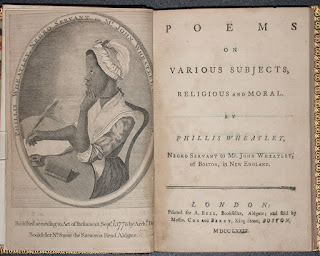 |
Phillis Wheatley. Poems on Various Subjects. London, 1783
|
Ironically, Boston printers refused to publish a compilation of Wheatley's poems, refusing to believe that a Negro slave could have written them, even after a panel of distinguished Bostonians, including John Hancock, interviewed her and vouched for her. Instead, the Wheatleys sent Phillis on a trip over the ocean to London, where she met a British publisher willing to publish her volume, and was received in the finest homes. Returning to America when she learned her mistress was ill, she continued to write, even as Boston rebelled against the British. After being published in London, her book sold well in Boston, and Phillis' fame grew. She was even invited to meet General Washington after writing a poem in his honor.
In an epilogue, Lasky relates briefly the last years of Wheatley's life; after receiving papers freeing her from slavery from the Wheatleys, she married and had three children, all of whom died in infancy. Her final poem, "Liberty and Peace," celebrated the end of the war, and she died in poverty at the age of thirty-one.
Back matter includes an index and a list of selected sources, as well as notes from the author and illustrator. The text includes a few brief quotations from Wheatley's poems.
At a brief 38 pages, with beautiful and abundant color illustrations, this very accessible biography is one step up from a picture book, and could be read aloud in class or by parents as well as read independently by students in about third grade and up. While the author provides plenty of information for a biographical report, the subject matter is fascinating and suitable for general reading as well as school assignments. Phillis Wheatley's remarkable rise from an illiterate slave to a literary figure celebrated on both sides of the Atlantic is an inspiration to share with children, particularly during Black History Month or Women's History Month.
Recommended for ages 7-12.Candlewick Press has recently reissued in paperback
Kathryn Lasky's biography of Sarah Breedlove Walker, originally published in 2000. In a brief 48 pages, Lasky chronicles the life of this remarkable woman, born into poverty to former slaves, who became a highly successful entrepreneur and philanthropist. Orphaned at the age of seven, Sarah had a difficult childhood, and married at the age of 14 to escape living with her sister and her cruel husband. She eventually moved to St. Louis where she worked as a laundress and diligently saved to be able to give her daughter the education she never had.
Because of poor nutrition, Sarah's hair began to fall out, and she began to work on a formula that would produce healthy hair for African-American women. After testing her products on herself, she began selling door-to-door, and eventually expanded her products into the Madam C. J. Walker Manufacturing Company, a business empire which made her the wealthiest black woman in America.
In a brief, easy to read narrative, Lasky hits on the highlights of Walker's life, emphasizing how remarkable her success was in an era when she had two strikes against her--being female and being black. My favorite scene in the book involves Waker attending a conference of African-American business leaders, all of whom (of course!) were men. Lasky describes how Walker tried unsuccessfully to get the attention of Booker T. Washington, so that she could speak. She finally sprang to her feet, relating how she came from the cotton fields of the South, promoting herself into the business of manufacturing hair goods. "'My object in life is not simply to make money for myself, but to use part of what I make in trying to help others,' continued Madam Walker...With these words, Madam Walker proved herself more than equal to any man in that room."
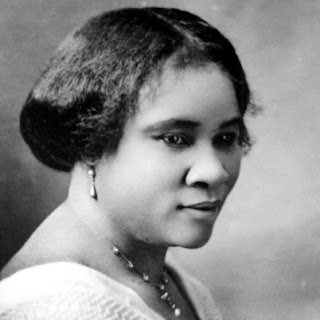 |
| Sarah Breedlove Walker |
An epilogue describes Walker's commitment to philanthropy and to civil rights; her dying words were "I want to live to help my race." Back matter also includes an illustrator's note an index, and selected sources.
Abundantly illustrated with beautiful full color watercolor paintings by
Nneka Bennett, Lasky's book is an inspirational tale that could be read aloud or read independently by children in elementary school.
Dr. King has been on my mind of late. Now that I am working as a full-time children's librarian, I was excited to organize a program for our family storytime in his honor. Since it happened that the program fell on his actual birthday, February 15, rather than the federal holiday, we read--and acted out--picture books about him, and sang Happy Birthday and instead of having cake, tasted his favorite dessert, pecan pie (served up in very small servings in cupcake liners!). The program turned into a family occasion, as my banjo-playing mother-in-law and my teenaged son came to teach the children and adults some of the iconic civil rights protest songs: We Shall Overcome, We Shall Not be Moved, and This Little Light of Mine.
There's a rich variety of books available on Dr. King, aimed at all ages, yet it was not difficult to choose which books I wanted to highlight. Here are some of my favorites, although I was not able to read them all at the storytime.
I Have a Dream, by Dr. Martin Luther King, Jr., illustrated by Kadir Nelson (Schwartz & Wade, 2012). Kadir Nelson has outdone himself with the magnificent oil paintings he produced to illustrate some of the most iconic excerpts from Dr. King's most famous speech (the complete text is included in the back of the book, as is a CD with Dr. King delivering the address). This is a book that should be in every American classroom and library. The dignified and statuesque artwork, combined with Dr. King's inspirational language, cannot fail to move anyone who sees and reads this book.
Martin's Big Words: The Life of Dr. Martin Luther King, Jr., by Doreen Rappaport, illustrated by Bryan Collier (Hyperion, 2001). In a book suitable for kindergartners on up, Rappaport brings Dr. King's career to life using simple but eloquent language and Dr. King's own powerful words, taken from various speeches and letters from throughout his lifetime. Combined with outstanding artwork by Bryan Collier, her text is perfect for reader's theatre; at my own program, three children read the words of Dr. King and I read the narrator part, making a very moving small piece of drama perfect for the classroom or library storytime.
My Uncle Martin's Big Heart, by Angela Farris, illustrated by Eric Velasquez (Abrams, 2010). This warm-hearted picture book tells Dr. King's life told from the perspective of his young niece. Dr. King comes through as a family man, Uncle M.L. who loved to laugh, not just an icon of the Civil Rights movement.
My Brother Martin: A Sister Remembers Growing Up with the Rev. Dr. Martin Luther King, Jr., by Christine King Farris (Simon & Schuster, 2003). In this outstanding book written by King's older sister, we see Martin Luther King as a mischievous young boy, not wanting to practice the piano, surrounded by a warm and loving well-educated family who tried to shield their children from the worst of segregation. Dr. King's father, stood up to the worst of the bigotry of that time, and the young King learns the importance of standing up for justice and equality. A powerful book that can be easily understood by elementary school-aged children.
Recommended for ages 7 and up.This new picture book biography by
Jen Bryant chronicles the unusual story of Horace Pippin, a self-taught African American folk artist who didn't complete his first painting until he was over forty years old. Born in 1888, Horace quickly demonstrated a love of drawing, and everyone loved his pictures. One day, Horace entered a magazine contest, and won his first art supplies--paints, colored pencils, and brushes. In 8th grade, he had to quit school to go to work to help out his family, but he continued making pictures using whatever materials he could find.
Horace joined the army and went to France to fight in World War I, and even in the horrible trenches, where conditions were miserable, Horace filled his notebooks with drawings for his friends. But a serious injury to his arm by a bullet left Horace unable to lift or move his arm the way he used to. Would he ever be able to draw again?
But Horace's desire to create was not easily stopped, and he managed to teach himself to paint by using his left hand to hold up his right. Through his art he expressed the pain of his war experiences, as well as chronicling a variety of other subjects from domestic scenes of women working in the kitchen to Bible stories and scenes of cotton fields. It took him three years to finish his first painting, and soon he was able to hang his paintings around town. But no one bought them, at least not until the head of a local artists' club saw Horace's pictures, and brought his friend, the famous painter N.C. Wyeth to see them. Soon Horace achieved great fame, and his paintings were collected by people from all over the world.
Back matter includes a historical note with further biographical background on Pippin, notes from the author and illustrator, and suggestions for further reading, as well as recommended websites on Pippin and quotation sources. The end papers show a map of the United States indicating places where we can see Pippin's paintings, along with reproductions of some of his original works.
I was not familiar with the work of Horace Pippin before reading this work. Jen Bryant's text, while accessible for young children, will spark the imagination of older children and even adults to explore further the work and life of this African-American artist. Bryant and illustrator
Melissa Sweet do a wonderful job of capturing not only the spirit of Pippin's artwork, but his determination and resolve to rise above the many difficulties he experienced in his life. Sweet, the author-illustrator of
Balloons over Broadway and the illustrator of more than eighty other picture books, manages to evoke Pippin's use of color and composition in her own illustrations. The illustrations are created using watercolor, gouache, and collage, and incorporate quotations from Pippin as well as images. Sweet writes in her illustrator's note that "Lettering Pippin's quotes within the illustrations gave me a way to illuminate his simple and heartfelt approach to making art."
This is a terrific book to share for Black History Month or any time you would like an inspirational picture book biography to share with children or a class.
Amazon has selected
A Splash of Red as one of its
Picture Books of the Month for January.
Recommended for ages 10-14.
In her new historical novel
Jump into the Sky, award-winning historical fiction author
Shelley Pearsall explores a little known footnote in World War II history--the 555th Parachute Infantry Battalion, the first black paratrooper unit in the U.S. Army.
The story of the 555th unfolds through the eyes of thirteen-year old Levi, who's been living with his aunt in Chicago while his father serves in a secret Army mission. It's May, 1945, and the war is drawing to close. Levi's aunt decides to send him off by train to stay with his father at his dad's last known address, an army post in North Carolina. Not only does his father not know he's coming, Levi arrives in the Jim Crow South without a clue as to the behavior expected of a "colored boy" and almost gets himself killed for trying to buy a Coke at the wrong store. And to make things more difficult, his father's unit has been sent all the way to Oregon. Will Levi have to go back to his aunt, who doesn't want him any more, or will he be able to find his father in Oregon? And will his father survive the dangerous mission assigned to the 555?
This novel is a powerful story of racism and courage in the not-too-distant days of the Jim Crow South and a segregated American military. Although the main characters of Levi and his father are fictitious, the novel is carefully researched and many of the incidents described really happened, including the scene at the country store with the Coca Cola. Moreover, the novel is peppered with colorful real soldiers from the 555th, including "Tiger Ted" Lowry, who once fought Joe Louis in an exhibition match. An author's note describes how she first learned of this battalion, which was part of a secret operation to protect the U.S. from Japanese balloon bombs. This balloon bombing strategy of the Japanese is certainly a "truth is stranger than fiction" story. Pearsall was fortunate to interview a veteran of the unit, Walter Morris. Further details on the 555th can be found at the unit's website,
triplenickle.com.
I would highly recommend this book to middle schoolers looking for a good adventure story that brings a little known part of World War II history to life.
Recommended for ages 5-10.
Young Alice Coachman, growing up in segregated Albany, Georgia, in the 1930's, just couldn't help herself. She wanted to soar and touch the sky.
"Bare feet shouldn't fly./Long legs shouldn't spin./Braids shouldn't flap in the wind./'Sit on the porch and be a lady,' Papa scolded Alice," this book about the future Olympic athlete begins. When she watched boys doing the high jump at a track meet, "Alice's feet tingled, wanting to try."
We see Alice's dreams growing bigger as she gets older, until finally the high school coach needed a jumper for a track and field tournament in Alabama. Her family was too poor to afford proper clothes for the competition, so her teachers pitched in and bought her shoes, shorts, and bright white socks. For the first time, she competed with the best black athletes in the South. In 1939, she won her first national medal, and soon she was asked to enroll at Tuskegee, where she'd be able to train with the best. Alice worked hard to pay her school fees.
Alice dreamed of the Olympics, but with the world consumed by war there were no games to enter. Could she still compete in 1948? Would she achieve her dream of a gold medal in the high jump--and finally touch the sky?
Written in a simple yet poetic style, this book captures the spirit of a true American heroine and a pioneer in sports, one who is not widely known today. It's a real "girl power" story, as well as a tale about overcoming prejudice. The stunning large format oil paintings, by
illustrator Eric Velasquez, with their vibrant colors and sweeping compositions, capture the intensity of Alice's story, and especially of her jumping.
An author's note shows photographs of the real Alice and her teammates and tells about what happened to Alice after her triumph at the Olympics. A bibliography is also included.
 1 Comments on Women's History Month Book Review: Touch the Sky: Alice Coachman, Olympic High Jumper, by Ann Malaspina (Albert Whitman, 2012), last added: 3/28/2012
1 Comments on Women's History Month Book Review: Touch the Sky: Alice Coachman, Olympic High Jumper, by Ann Malaspina (Albert Whitman, 2012), last added: 3/28/2012
Recommended for ages 8-12.Another excellent choice for Black History Month, this historical fiction novel for middle-grade readers, takes a little known race riot and coup d'etat that occurred in Wilmington, North Carolina, in 1898 as the inspiration for creating a compelling story of eleven-year old Moses and the destruction of the middle-class African-American community in which he lived. It's just one generation after the end of slavery--Moses' own grandmother, Boo Nanny, was born a slave, but in the years since Emancipation, Moses' family has risen into the middle class. His father is college-educated, works for the local black newspaper, and is also a town alderman. When the editor of the black newspaper writes an editorial in which he suggests that it's no worse for a black man to be intimate with a white woman than for a white man to be intimate with a black woman, "big trouble's a-brewing" in Wilmington. Will Moses and his family escape the ensuing violence that erupts? Creating a compelling voice for young Moses, author Barbara Wright has created a moving and shocking story about the Jim Crow South that received well deserved star reviews from Kirkus, Publisher's Weekly, School Library Journal, and Horn Book. You can read an excerpt at her website. Her website also offers resources for teachers, including a teacher's guide from Random House. This book is a must-have for school and pubic libraries!
Recommended for ages 5-10.
Just in time for Black History Month is a handsome new picture book biography of iconic abolitionist, orator and author Frederick Douglass, written and illustrated by the husband-wife team of author Lesa Cline-Ransome and illustrator James E. Ransome. Told in the first person by Frederick, the story introduces us to the young slave's boyhood and the influence that the power of reading had on his life. Raised by his grandmother as a young child, Frederick was sent away at the tender age of eight from the Maryland plantation that had always been his home to live with the brother-in-law of his mistress in Baltimore. His new mistress, Sophia Auld, had never had a slave before, and treated Frederick more like a paid servant, even teaching him his letters. When her husband found out about their lessons, he was furious, and his wife was forbidden from teaching her young slave: "He should know nothing but to obey his master--to do as he is told to do," he shouted..."If you teach him how to read, there will be no keeping him. It would forever unfit him to be a slave." But once given a taste of learning, Frederick was not to be stopped, and he found every opportunity to practice his letters in secret, even buying a newspaper with coins he saved from tips from running errands for his master. But when his master died, Frederick was sent back to the plantation that was his birthplace, where he was sent to work in the fields with the other slaves. His thirst for learning, however, would not die, and he began teaching other slaves to read, despite the very real dangers. And soon he was plotting to escape, using his knowledge of words to set him free by forging passes to run to the North. This book ends somewhat abruptly with Douglass plotting his escape; an author's note tells the reader that the escape attempt was unsuccessful but Frederick succeeded three years later in escaping to New York, where he changed his name and became a famous abolitionist. The text is based on Douglass' s own Narrative of the Life of Frederick Douglass. Back matter includes a short bibliography, and a timeline of Douglass' life, which like the narrative, ends with his escape to New York in 1838. Frederick's story is riveting, and it leaves the reader wanting to find out more about Douglass' life. This book would make an excellent read-aloud for classrooms, but it is not a book that could be recommended for classroom reports, since it focuses on a narrow segment of Douglass' life. However, it could enrich a unit on African-American history, abolitionism, and slavery. I particularly enjoyed the traditional artwork rendered in acrylic and oil paint; the rich blues in particular are evocative of the Maryland shore where Douglass spent many years of his boyhood. The artwork has a monumental quality which fits the story of the great man Douglass was to become.
Recommended for ages 5-10. There are so many children's books about Martin Luther King, and I would never have guessed from the appealing cover illustration on this title that this was a book that touched on civil rights and especially on Dr. King. Belle, the Last Mule at Gee's Bend, is a delightful historical fiction picture book which tells the story of an ordinary mule named Belle who leads an extraordinary life in the small town of Gee's Bend, Alabama. At the beginning of this tale, we meet Alex, a bored young boy who is waiting for his mother to buy one of the famous quilts that Gee's Bend is known for. With nothing to do but watch an old mule, he's happy to listen to an old lady from the town tell him a story about why the mule, who's eating her greens, is so special. It turns out that Martin Luther King visited Gee's Bend to encourage its black citizens to vote. But when whites got wind of the voting drive, they shut down the ferry that crossed the river to Camden, where voting took place. That didn't stop the courageous citizens of Gee's Bend, who hooked up wagonloads full of people to mules, including Belle, to go around the river to vote. But that wasn't the end of Belle's special mission; she was also called upon as one of a team to pull Dr. King's coffin through the streets of Atlanta during his funeral parade. Alex learns an important lesson from this touching story: even an old mule can be a hero. An author's note provides further details about Belle's story, particularly how Dr. King himself wanted mules to pull his casket when he died, with the mules serving as a powerful symbol of King's fight to help poor blacks across the country.  | | Belle pulling Dr. King's casket |
View Next 16 Posts
|
 Radiant Child: The Story of Young Artist Jean-Michel Basquiat
Radiant Child: The Story of Young Artist Jean-Michel Basquiat Javaka Steptoe apparently doesn’t like to make things easy for himself. If he wanted to, he could illustrate all the usual African-American subjects we see in books every year. Your Martin Luther Kings and Rosa Parks and George Washington Carvers. So what projects does he choose instead? Complicated heroes who led complicated lives. Artists. Jimi Hendrix and guys like that. Because for all that kids should, no, MUST know who Basquiat was, he was an adult with problems. When Steptoe illustrated Gary Golio’s bio of Hendrix (Jimi: Sounds Like a Rainbow) critics were universal in their praise. And like that book, Steptoe ends his story at the height of Basquiat’s fame. I’ve seen some folks comment that the ending here is “abrupt” and that’s not wrong. But it’s also a natural high, and a real time in the man’s life when he was really and truly happy. When presenting a subject like Basquiat to a young audience you zero in on the good, acknowledge the bad in some way (even if it’s afterwards in an Author’s Note), and do what you can to establish precisely why this person should be mentioned alongside those Martin Luther Kings, Rosa Parks, and George Washington Carvers.
Javaka Steptoe apparently doesn’t like to make things easy for himself. If he wanted to, he could illustrate all the usual African-American subjects we see in books every year. Your Martin Luther Kings and Rosa Parks and George Washington Carvers. So what projects does he choose instead? Complicated heroes who led complicated lives. Artists. Jimi Hendrix and guys like that. Because for all that kids should, no, MUST know who Basquiat was, he was an adult with problems. When Steptoe illustrated Gary Golio’s bio of Hendrix (Jimi: Sounds Like a Rainbow) critics were universal in their praise. And like that book, Steptoe ends his story at the height of Basquiat’s fame. I’ve seen some folks comment that the ending here is “abrupt” and that’s not wrong. But it’s also a natural high, and a real time in the man’s life when he was really and truly happy. When presenting a subject like Basquiat to a young audience you zero in on the good, acknowledge the bad in some way (even if it’s afterwards in an Author’s Note), and do what you can to establish precisely why this person should be mentioned alongside those Martin Luther Kings, Rosa Parks, and George Washington Carvers. The precise age when a child starts to feel that their art is “not good” anymore because it doesn’t look realistic or professional enough is relative. Generally it happens around nine or ten. A book like Radiant Child, however, is aimed at younger kids in the 6-9 year old range. This is good news. For one thing, looking at young Basquiat vs. older Basquiat, it’s possible to see how his art is both childlike and sophisticated all at once. A kid could look at what he’s doing in this book and think, “I could do that!” And in his text, Steptoe drills into the reader the fact that even a kid can be a serious artist. As he says, “In his house you can tell a serious ARTIST dwells.” No bones about it.
The precise age when a child starts to feel that their art is “not good” anymore because it doesn’t look realistic or professional enough is relative. Generally it happens around nine or ten. A book like Radiant Child, however, is aimed at younger kids in the 6-9 year old range. This is good news. For one thing, looking at young Basquiat vs. older Basquiat, it’s possible to see how his art is both childlike and sophisticated all at once. A kid could look at what he’s doing in this book and think, “I could do that!” And in his text, Steptoe drills into the reader the fact that even a kid can be a serious artist. As he says, “In his house you can tell a serious ARTIST dwells.” No bones about it.






















![Poet-interior-FINAL-page-004[1]](https://kidlitreviews.files.wordpress.com/2015/08/poet-interior-final-page-0041.jpg?w=400&h=301)
![Poet-interior-FINAL-page-010[1]](https://kidlitreviews.files.wordpress.com/2015/08/poet-interior-final-page-0101.jpg?w=403&h=234)





























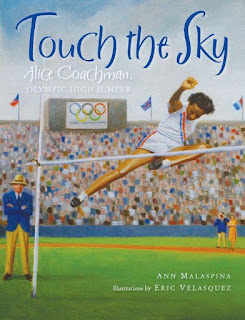




A great and timely list! Thank you, Betsy.
Thank you for this list. I hope parents and educators are encouraged to replace books with poor or inaccurate depictions of slavery with those mentioned. Armed with history, all children will be better prepared to identify and question racial representations, or the lack therefore, in all areas.
Thank you for this annotated list. Here are more carefully selected, recommended books for children (elementary and above) on slavery and resistance: http://www.tfcbooks.org/best-recommended/slavery The list includes picture books, chapter books, YA, and the ever essential background reading for adults. Before reading any of these books, we encourage parents and teachers to consider their own background knowledge and the developmental needs of young children as outlined here, “Considerations for Early Childhood and Early Elementary Educators on Slavery and Resistance”: http://www.teachingforchange.org/young-children-slavery-resistance
What a good-looking list! And I haven’t read a single one, yet! I think I’ll start with Nathan Hale and Chris Barton.
I’ve only read John Roy Lynch. Off to the library. Thank you, Betsy!
I’d include Don Tate’s Poet on this list!
Yep, I was just trying not to repeat authors and illustrators too much. But that’s a great book too.
I really like Dave the Potter by Laban Carrick Hill and another on the same figure, a novel in verse by the late Andrea Cheng, Etched in Clay.
And of course, Show Way by Jacqueline Woodson.
Thank you for this list. Another excellent middle grade novel is Crow by Barbara Wright.
What an awesome list!! And I’m pleased as can be, that our library has all but two. Thank you so for sharing.
Yep, but that book is more of a birth-of-Jim-Crow title than a slavery book. I believe it’s set in 1898.
A great book, but it published in 2005. A little out of my 5-year range.
Dave the Potter was on the Huffington Post list, so I only didn’t include it for that reason. The Cheng book is great. Shoulda had it here. Good thinking!
[…] Amazing Age was also featured, along with I Lay My Stitches Down, on Betsy Bird’s list of recent children’s books about slavery. Bird calls The Amazing Age, which is featured at the top of the list, the “[b]est dang book […]